Panasonic of North America SU-ZT1 Home Theater Audio System User Manual
Panasonic Corporation of North America Home Theater Audio System Users Manual
Manual
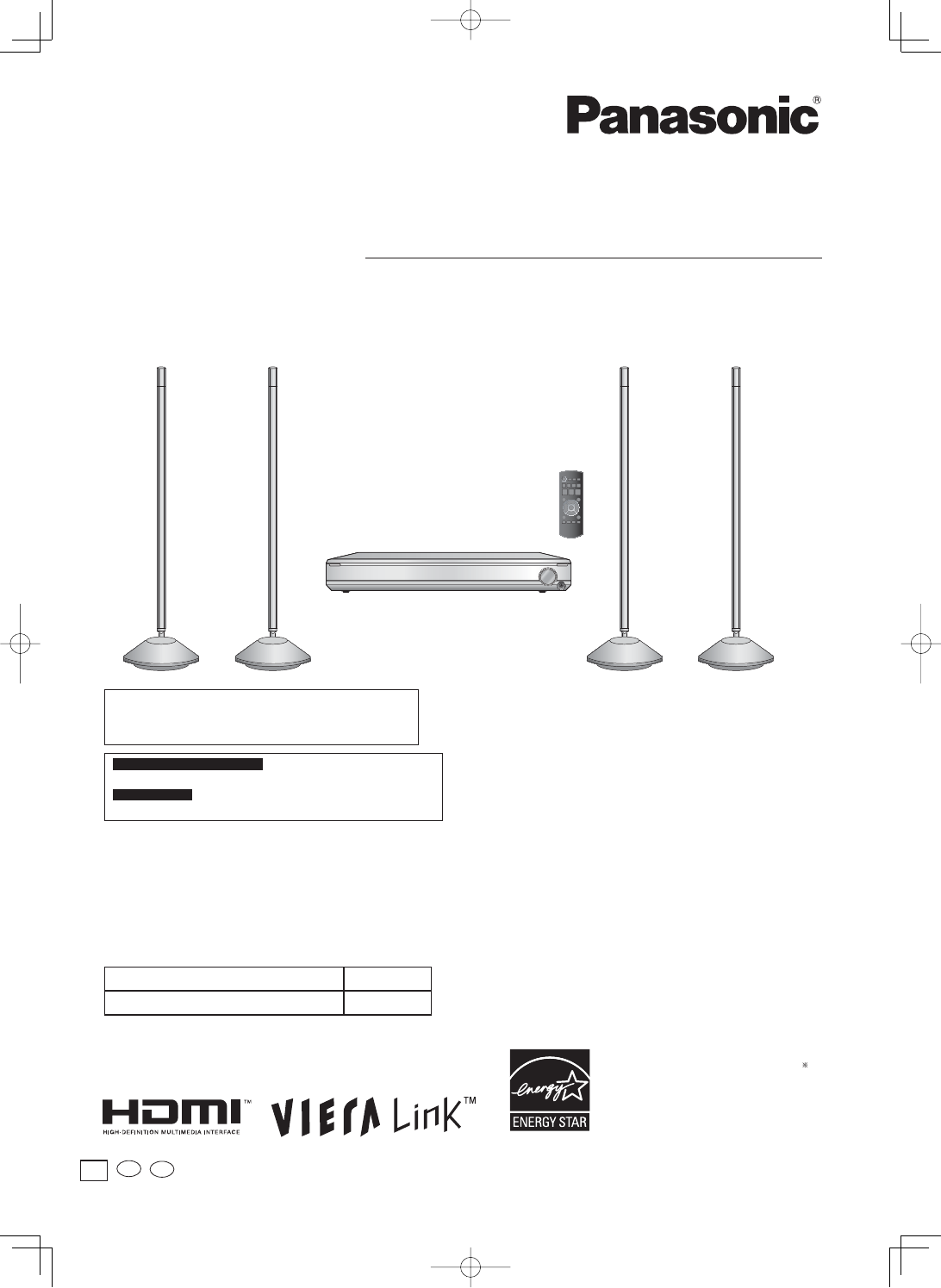
Operating Instructions
Home Theater Audio System
Model No. SC-ZT1
RQT9471-Y
H0409RT0
Dear customer
Thank you for purchasing this product.
For optimum performance and safety, please read these instructions carefully.
Before connecting, operating or adjusting this product, please read the instructions completely.
Please keep this manual for future reference.
PP
For U.S.A. and Puerto Rico only
The warranty can be found on page 30.
For Canada only
The warranty can be found on page 31.
If you have any questions contact
In the U.S.A. and Puerto Rico: 1-800-211-PANA(7262)
In Canada: 1-800-561-5505
As an ENERGY STAR® Partner ,
Panasonic has determined that this
product meets the ENERGY STAR®
guidelines for energy efficiency.
Ú For Canada only: The word “Participant” is used in place of
the word “Partner”.
En Cf
SC-ZT1 Components
Main unit (control box part) SU-ZT1
Speakers SB-ZT1
5%<622436;'PKPFF
5%<622436;'PKPFF
ඦ೨
ඦ೨
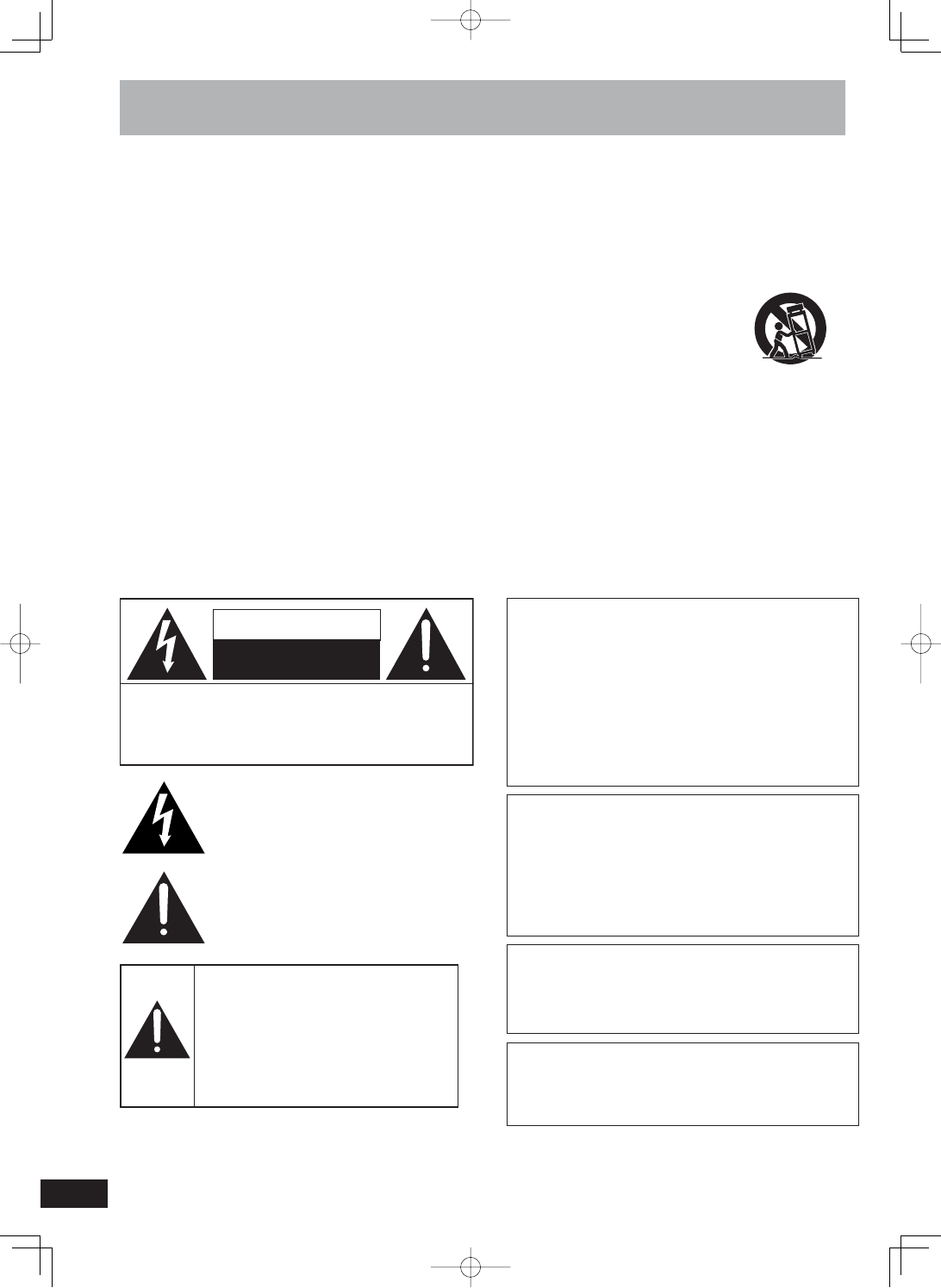
RQT9471
2
CAUTION!
DO NOT INSTALL OR PLACE THIS UNIT IN A
BOOKCASE, BUILT-IN CABINET OR IN ANOTHER
CONFINED SPACE. ENSURE THE UNIT IS WELL
VENTILATED. TO PREVENT RISK OF ELECTRIC SHOCK
OR FIRE HAZARD DUE TO OVERHEATING, ENSURE
THAT CURTAINS AND ANY OTHER MATERIALS DO
NOT OBSTRUCT THE VENTILATION VENTS.
The lightning fl ash with arrowhead symbol, within
an equilateral triangle, is intended to alert the user
to the presence of uninsulated “dangerous voltage”
within the product’s enclosure that may be of
suffi cient magnitude to constitute a risk of electric
shock to persons.
The exclamation point within an equilateral triangle
is intended to alert the user to the presence of
important operating and maintenance (servicing)
instructions in the literature accompanying the
appliance.
WARNING:
TO REDUCE THE RISK OF FIRE, ELECTRIC SHOCK OR
PRODUCT DAMAGE,
*DO NOT EXPOSE THIS APPARATUS TO RAIN,
MOISTURE, DRIPPING OR SPLASHING AND THAT NO
OBJECTS FILLED WITH LIQUIDS, SUCH AS VASES,
SHALL BE PLACED ON THE APPARATUS.
*USE ONLY THE RECOMMENDED ACCESSORIES.
*DO NOT REMOVE THE COVER (OR BACK); THERE
ARE NO USER SERVICEABLE PARTS INSIDE. REFER
SERVICING TO QUALIFIED SERVICE PERSONNEL.
The socket outlet shall be installed near the equipment and easily
accessible.
The mains plug of the power supply cord shall remain readily
operable.
To completely disconnect this apparatus from the AC Mains,
disconnect the power supply cord plug from AC receptacle.
CAUTION!
Do not place anything on top of this unit or block the heat radiation
vents in any way. In particular, do not place DVD recorder or CD/
DVD players on this unit as heat radiated from it can damage your
software.
CAUTION
CAUTION: TO REDUCE THE RISK OF ELECTRIC
SHOCK, DO NOT REMOVE SCREWS.
NO USER-SERVICEABLE PARTS INSIDE.
REFER SERVICING TO QUALIFIED
SERVICE PERSONNEL.
RISK OF ELECTRIC SHOCK
DO NOT OPEN
1) Read these instructions.
2) Keep these instructions.
3) Heed all warnings.
4) Follow all instructions.
5) Do not use this apparatus near water.
6) Clean only with dry cloth.
7) Do not block any ventilation openings. Install in accordance
with the manufacturer’s instructions.
8) Do not install near any heat sources such as radiators, heat
registers, stoves, or other apparatus (including amplifi ers)
that produce heat.
9) Do not defeat the safety purpose of the polarized or
grounding-type plug. A polarized plug has two blades with
one wider than the other. A grounding-type plug has two
blades and a third grounding prong. The wide blade or the
third prong are provided for your safety. If the provided
plug does not fi t into your outlet, consult an electrician for
replacement of the obsolete outlet.
10) Protect the power cord from being walked on or pinched
particularly at plugs, convenience receptacles, and the
point where they exit from the apparatus.
11) Only use attachments/accessories specifi ed by the
manufacturer.
12) Use only with the cart, stand, tripod,
bracket, or table specifi ed by the
manufacturer, or sold with the apparatus.
When a cart is used, use caution when
moving the cart/apparatus combination to
avoid injury from tip-over.
13) Unplug this apparatus during lightning storms or when
unused for long periods of time.
14) Refer all servicing to qualifi ed service personnel. Servicing
is required when the apparatus has been damaged in any
way, such as power-supply cord or plug is damaged, liquid
has been spilled or objects have fallen into the apparatus,
the apparatus has been exposed to rain or moisture, does
not operate normally, or has been dropped.
Read these operating instructions carefully before using the unit. Follow the safety instructions on the unit and the applicable
safety instructions listed below. Keep these operating instructions handy for future reference.
IMPORTANT SAFETY INSTRUCTIONS
Caution
• Use the speakers only with the recommended
system. Failure to do so can damage the
amplifier and speakers, and can cause fire.
Consult a qualified service person if damage
occurs or if a sudden change in performance
is apparent.
• Do not attach these speakers to walls or
ceilings.
5%<622436;'PKPFF
5%<622436;'PKPFF
ඦ೨
ඦ೨
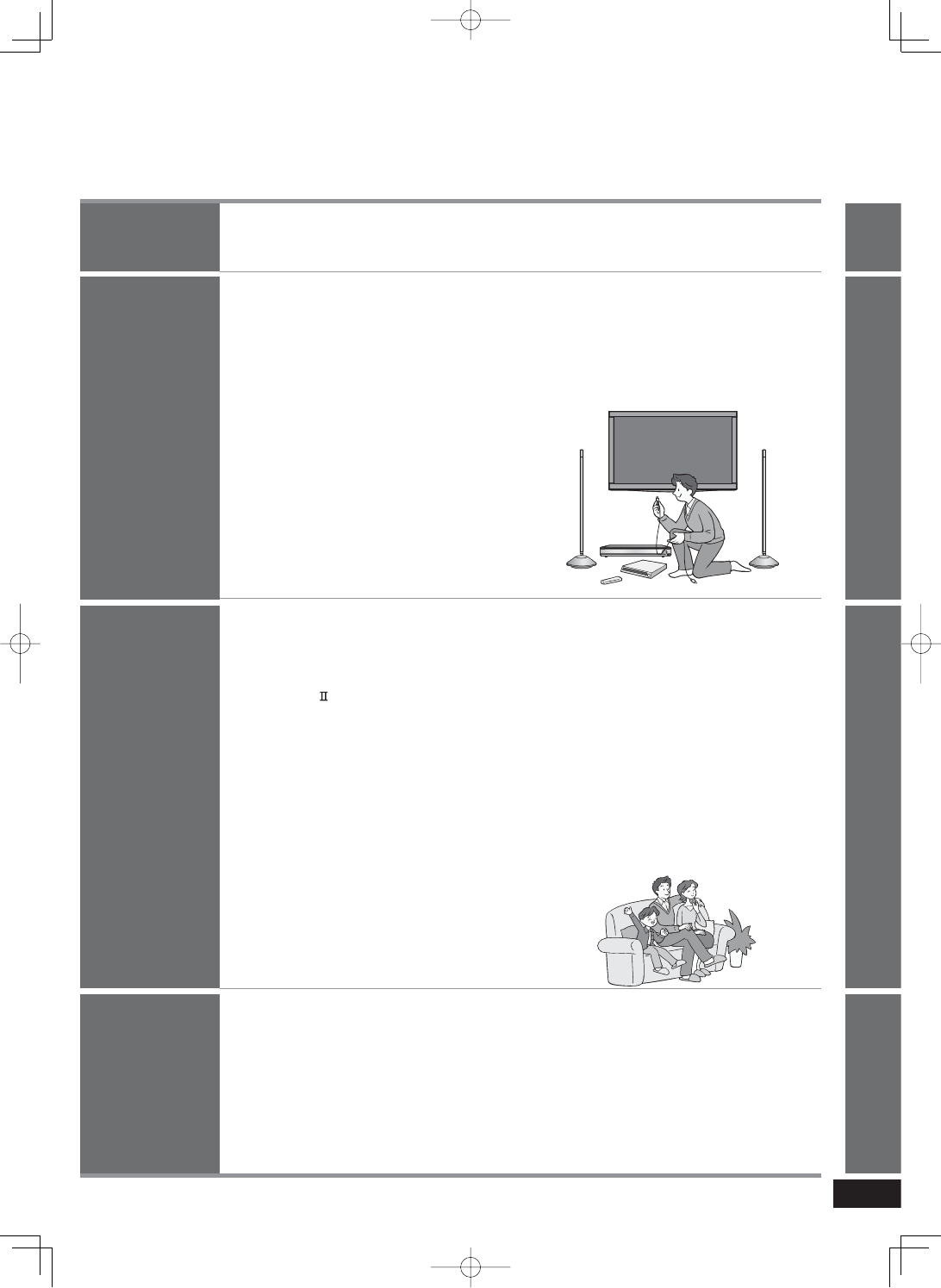
RQT9471
3
Before use
Table of contents
Setting up your Home
Theater system .............................. 4
Supplied accessories .................... 5
Control guide ................................. 5
Remote control preparation ......... 7
Connection
Installation....................... 8
Wireless functions ...........................................8
Home Theater
connections .................... 9
Basic connections .......................... 9
Connecting equipment with HDMI
terminal (TV, DVD recorder, etc.) ....................9
Connecting STB etc. .....................................10
Setting for automatically switching the input source to STB
.....10
Connecting cables to audio terminals (DVD player, etc.)
....10
Connecting equipment without
HDMI terminal
(DVD player, VCR, etc.) ................. 11
Other connections ........................ 12
To connect a second set of equipment that supports HDMI .......
12
To connect audio equipment (CD player, etc.)
.....12
To connect a subwoofer (not included) .........12
AC power supply connection ..... 12
Speaker setting ............. 13
Setting the speakers ..................... 13
Checking the speaker setting ...... 14
Setting front speakers only .......... 15
Changing the number of speakers to 2. ........15
Product Service ........................... 29
Listening caution ......................... 29
Limited Warranty
(ONLY FOR U.S.A.
AND PUERTO RICO) .................... 30
Limited Warranty
(ONLY FOR CANADA) ................. 31
Troubleshooting
and other
information
Error messages ........................... 25
Using with headphones .............. 25
Specifi cations .............................. 25
Troubleshooting guide ................ 26
Digital signals that can be
played on this system ................. 27
Maintenance ................................. 27
Glossary ....................................... 28
Play
Adjusting sound quality .................................21
Adjusting the volume balance of front speakers ...
21
Setting distances ...........................................22
Setting 7.1-channel virtual surround .............22
Reducing standby power consumption
(In standby condition (HDMI off mode)) ........22
VIERA Link “HDAVI Control” setting ..............23
Adjusting the time lag between audio and
video by delaying audio output ......................23
Switching between dual sounds ....................23
Clear audio at low volume .............................23
Switching the attenuator ...............................23
Switching the input signal detection setting
......24
Reset (factory settings) .................................24
When other equipment (mini component system,
AV amp, etc.) manufactured by Panasonic operates
with the remote control operations of this system
....24
Enjoying movies and music
.... 16
Enjoying sound fi eld effects ............ 17
Surround playback .............................................17
SFC (Sound Field Control) ................................17
Dolby Pro Logic ..............................................17
Canceling sound fi eld effects .............................17
When using only front speakers ........................17
Dolby Virtual Speaker ...................................17
SFC (Sound Field Control) ............................17
Using the VIERA Link
“HDAVI Control™” ....................... 18
What you can do with VIERA Link “HDAVI Control”
..18
Functions and settings ............... 20
Using “WHISPER-MODE SURROUND” .......20
Using “GAME” ...............................................20
Muting ...........................................................20
Adjusting the bass (woofer part) output ........20
Adjusting the surround speaker output .........20
Adjusting the surround speaker output
using the test signal ......................................21
Setup menu items .........................................21
Before use
Troubleshooting and
other information ConnectionPlay
5%<622436;'PKPFF
5%<622436;'PKPFF
ඦ೨
ඦ೨
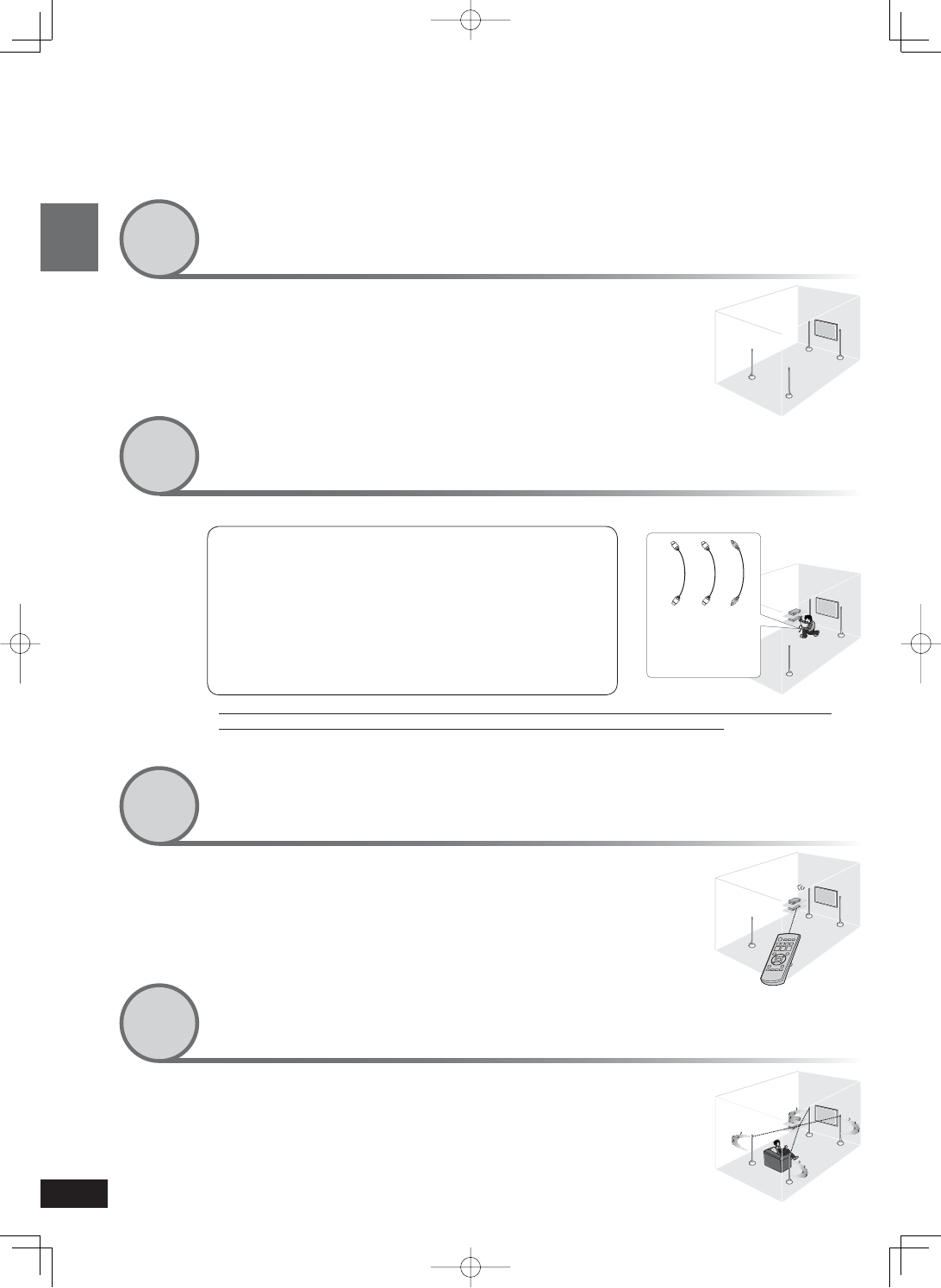
RQT9471
4
Installing the speakers (➜ page 8)
Step
1
You can make your preferred setting because speaker
cords are not required.
• Make sure to place the speakers on a flat, stable surface so there is no
danger of them falling over.
• AC power supply cord (included) is necessary for each speaker.
Connecting the television and DVD recorder
(➜ page 9)
(Peripheral equipment and cables are not included unless otherwise mentioned.)
Step
2
Enjoying movies and music (➜ page 16)
Enjoy surround sound with DVDs, TV, and other
sources.
• Audio is transmitted wirelessly.
㨪ۭ
Setting the speakers (➜ page 13)
Use the remote control for speaker setting.
• Make sure to make the speaker setting when using for the first time after
purchase.
Step
3
Step
4
Before use
Setting up your Home Theater system
Setting up your Home Theater system
Connecting TV
Necessary cable:
(For images and audio) HDMI cable: 1 (not included)
(For audio) Optical fi ber cable: 1 (not included)
Connecting recorder
Necessary cable:
(For images and audio) HDMI cable: 1 (not included)
• Only with HDMI cable connection, you cannot enjoy TV sounds on this system. Connect TV and the main unit
using the optical fiber cable (or stereo connection cable) to enjoy TV sound on this system.
• Connect with an HDMI cable for high-quality audio and video.
• This connection requires HDMI terminals on both the television and the DVD recorder.
I need 2 HDMI
cables and 1
optical fi ber cable
for connections.
Install and connect the main unit and other equipment.
5%<622436;'PKPFF
5%<622436;'PKPFF
ඦ೨
ඦ೨
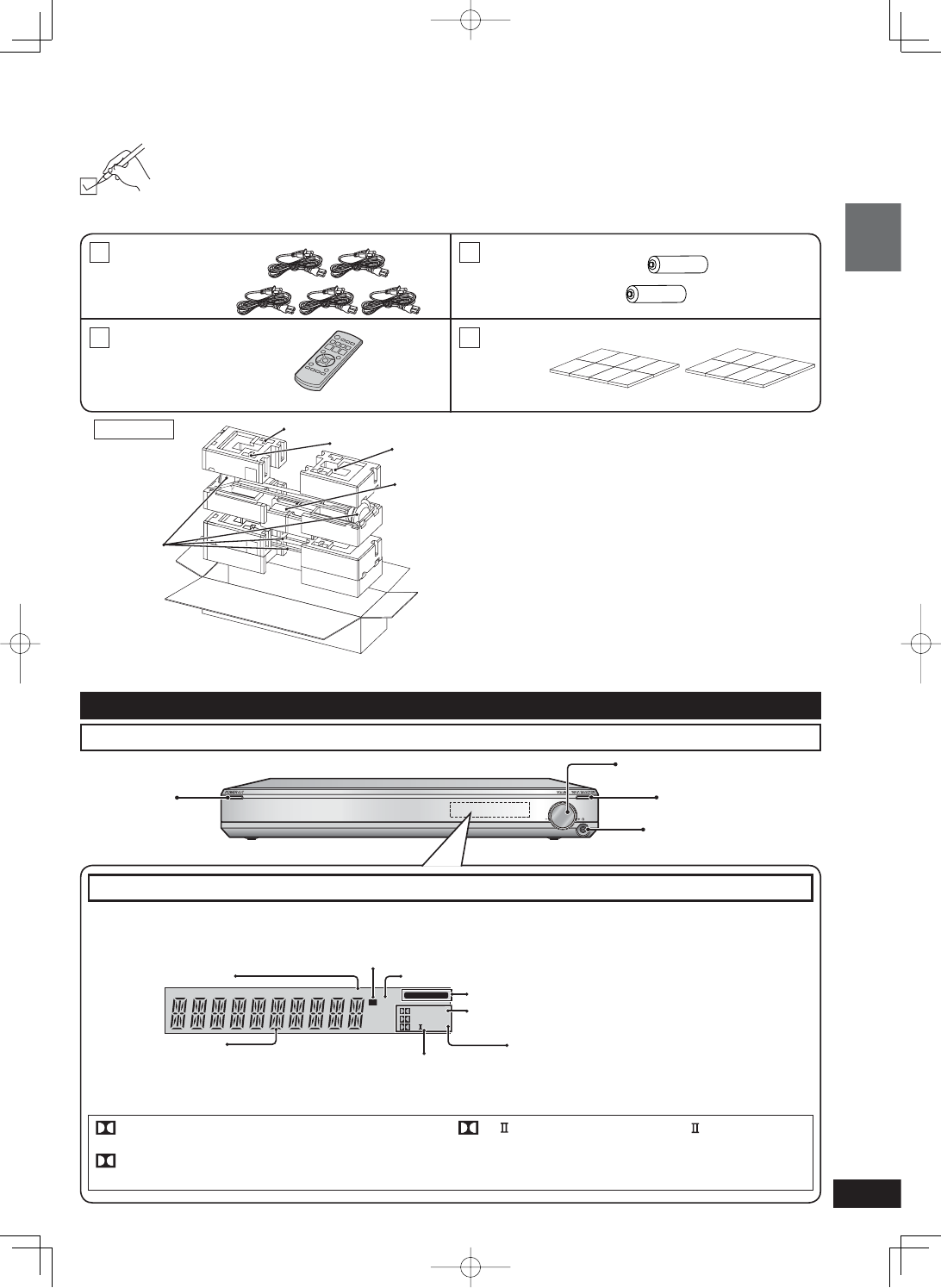
RQT9471
5
Supplied accessories/Control guide
Before use
Keep the Leg cushion out of reach of children to prevent swallowing.
Please check and identify the supplied accessories.
Use numbers indicated in parentheses when asking for replacement parts.
(Product numbers correct as of April 2009. These may be subject to change.)
Only for U.S.A. and Puerto Rico: To order accessories, refer to “Accessory Purchases (United States and Puerto
Rico)” on page 30.
Only for Canada: To order accessories, call the dealer from whom you have made your purchase.
Supplied accessories
Main unit (Control box)
Control guide
Front view
Display
PCM
W
DIGITAL DTS
PL
SFC
MIX
VS
DIGITAL INPUT
ft
Digital surround signal/Sound fi eld
(➜ below, page 17)
When input signal is digital
When PCM signal is being input
or the input signal setting is fi xed
to PCM (➜ page 24)
General display
When the input signal setting is fi xed to DTS
(➜ page 24)
Wireless Link display
(Displayed when wireless speakers are properly operating.)
(➜ page 14)
When the sound fi eld effect is off
by pressing [–SETUP, OFF] (➜ page 17)
or when using headphones (➜ page 25)
Standby/on
switch
(➜ pages 13, 16)
For adjusting volume
(➜ page 16)
[INPUT SELECTOR]
switch (➜ page 16)
For connecting
headphones (➜ page 25)
DIGITAL : Dolby Digital sources
DTS : DTS sources
VS : When Dolby Virtual Speaker is working
SFC : When SFC mode is being used
PL : When Dolby Pro Logic decoder is being
used (When using Dolby Virtual Speaker
for 2-channel stereo source)
• When taking out speakers, hold the pole and base parts
(➜ page 6).
Packing plan
Speakers
Remote control
Batteries
Main unit
AC power
supply cords
5 AC power supply cords
(K2CB2CB00021)
2 Batteries
(R6, AA)
1 Remote control
(N2QAYB000417)
Leg cushions (2 sheets: 16 pieces)
(RFA3045)
Unit of distance: ft (feet), 1 feet=0.3 meter (➜ page 22)
5%<622436;'PKPFF
5%<622436;'PKPFF
ඦ೨
ඦ೨
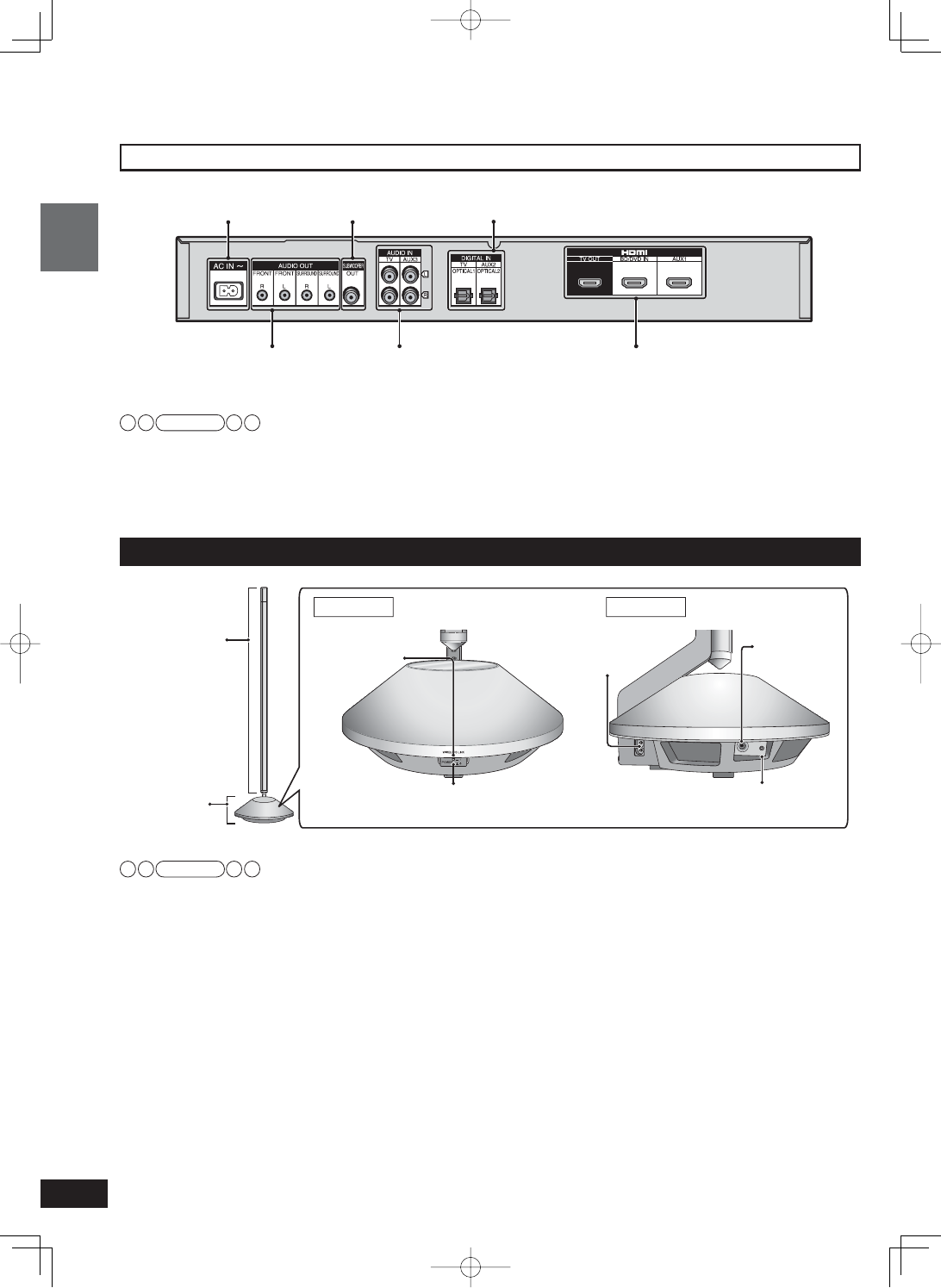
RQT9471
6
Speaker (with built-in amplifi er)
AC IN 㨪
TEST ID
Pole
(mid-high part)
Base
(woofer part)
AC inlet
(➜ page 12)
TEST
terminal
[WIRELESS LINK]
indicator
(➜ page 13)
ID switch
For switching the speaker
“ON/OFF” (➜ page 13)
Front view Side view
Note
TEST terminal: This is used to check the product operation status. Only used in factory. Do not insert a foreign object.
ID switch: This is used to check the product operation status and not used regularly.
Control guide
Before use
Control guide
Note
The audio output terminals can be used when you do not use the wireless function and play back on other speakers via an external
amplifi er. Use commercially available monaural audio cables (monaural mini plug/pin plug) to connect to audio input terminals of an
external amplifi er channel by channel.
Rear view
AC inlet (➜ page 12)
Subwoofer output
terminal (➜ page 12) Digital input terminal (➜ pages 9 to 11, 19)
HDMI terminal (➜ pages 9, 10, 12, 19)Audio input terminal
(➜ pages 9 to 12)
Audio output terminal
(➜ below)
5%<622436;'PKPFF
5%<622436;'PKPFF
ඦ೨
ඦ೨
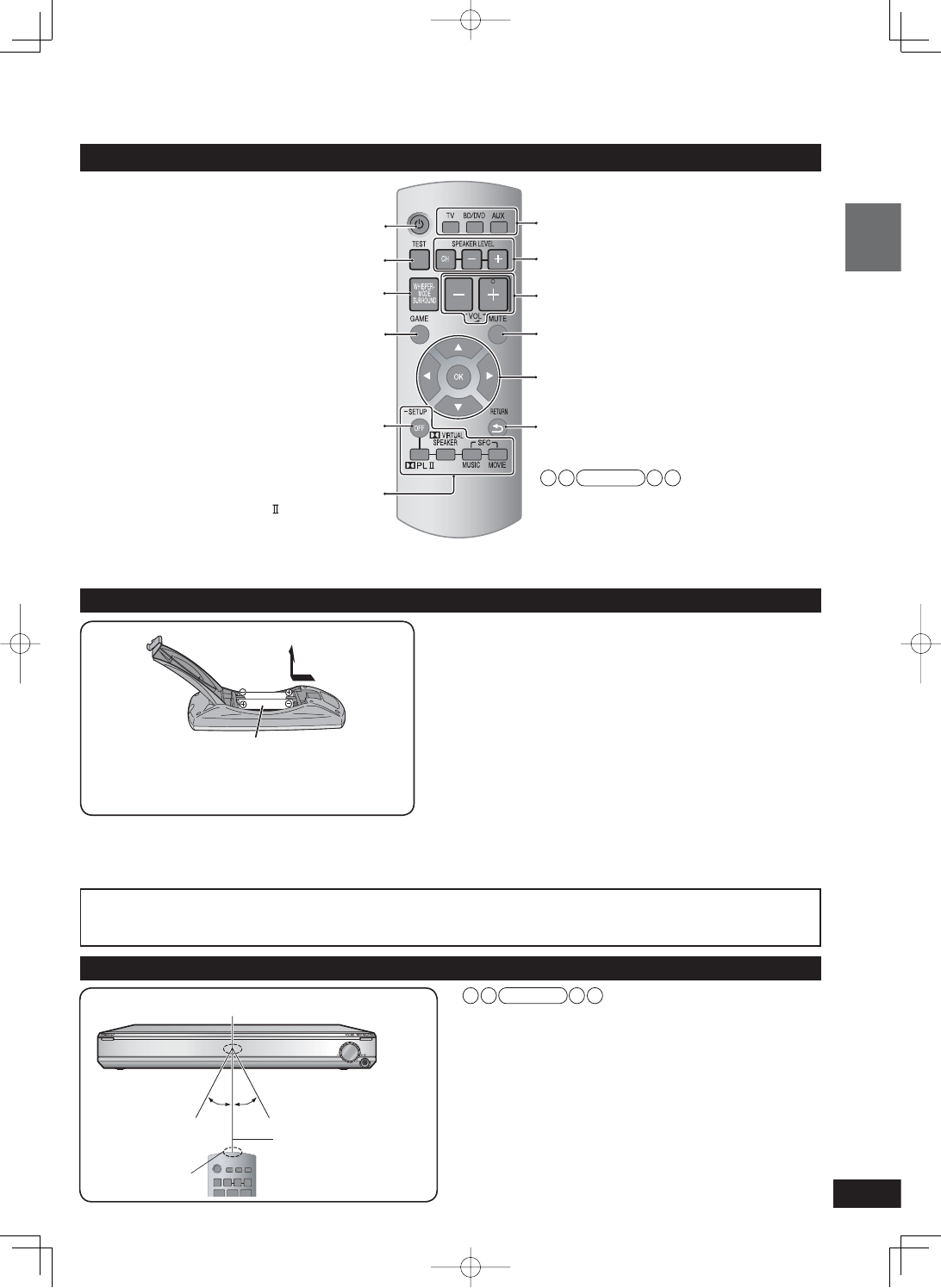
RQT9471
7
Remote control
Standby/on button (➜ page 16) Input mode and remote control code
buttons (➜ pages 16, 24)
For adjusting speaker output
(➜ pages 20, 21)
Test signal output (➜ pages 14, 21)
For adjusting the volume (➜ page 16)
For using “WHISPER-MODE SURROUND”
(➜ page 20)
Muting (➜ page 20)
For returning to the previous menu
(➜ pages 10, 15, 21 to 24)
For using “GAME” (➜ page 20)
For entering setup mode
(➜ pages 10, 15, 21 to 24)
For adjusting/activating settings
(➜ pages 10, 15, 21 to 24)
For selecting or canceling
Dolby Virtual Speaker,
Dolby Pro Logic and SFC mode
(➜ page 17)
Remote control preparation
Inserting the batteries
(R6/LR6, AA)
Press on the tab to open.
Insert so the poles (( and )) match those in the
remote control.
Use manganese batteries or alkaline batteries.
• Do not mix old and new batteries.
• Do not use different types of batteries at the same time.
• Do not take apart or short circuit.
• Do not attempt to recharge alkaline or manganese batteries.
• Do not use batteries if the covering has been peeled off.
• Do not heat or expose to fl ame.
• Do not leave the batteries in an automobile exposed to direct
sunlight for a long period of time with doors and windows
closed.
Mishandling of batteries can cause electrolyte leakage which
can severely damage the remote control.
Remove the batteries if the remote control is not going to be
used for a long period of time. Store them in a cool, dark place.
CAUTION
Danger of explosion if battery is incorrectly replaced. Replace only with the same or equivalent type recommended by
the manufacturer. Dispose of used batteries according to the manufacturer’s instructions.
Control guide/Remote control preparation
Before use
Note
For remote control buttons used for speaker
setting, see pages 13 to 15.
Remote control signal sensor
Main unit
Using the remote control
• Do not place an object between the signal sensor and
the remote control.
• Do not expose the signal sensor to the direct sunlight or
the strong light of a fl uorescent lamp.
• Keep the transmission window and the system’s sensor
free from dust.
Within 7 meters
(23 feet) at the front
(The remote controlling
range varies according
to the angle)
Transmission
window
Note
Approx.
30º
Approx.
30º
5%<622436;'PKPFF
5%<622436;'PKPFF
ඦ೨
ඦ೨
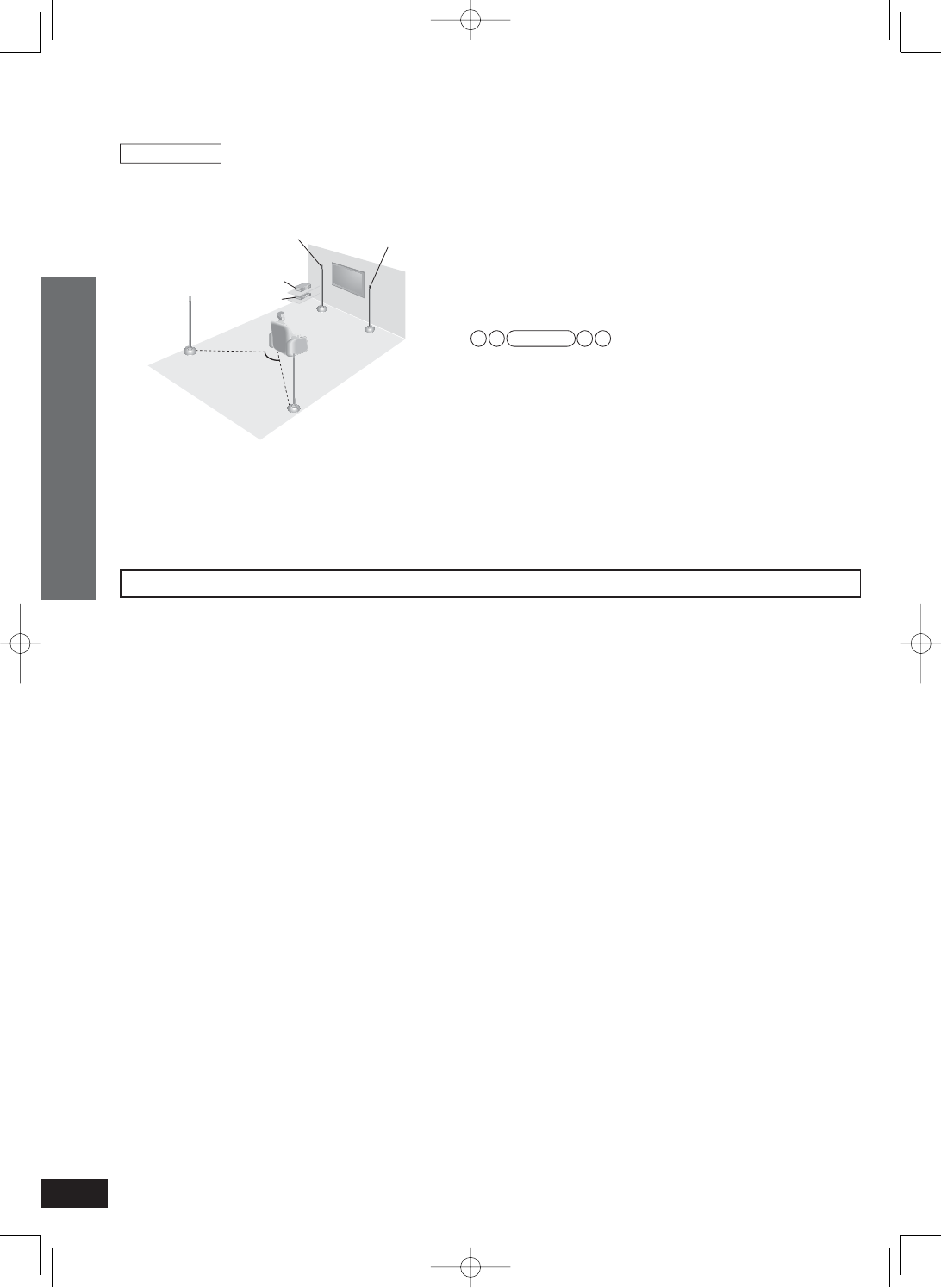
RQT9471
8
Installation
Wireless functions
As this system uses a frequency band of 2.4 GHz, the radio waves may be interrupted by an obstacle. Depending on the
surrounding environment (i.e. radio wave interruption from outside, etc.) or the building structure where this system is used (i.e. wall
that easily refl ects radio waves, etc.), sounds may be cut or noise may occur.
Install this system properly paying attention to the following descriptions.
Equipment certifi cation
As this system received Technical Conditions compliance certifi cation based on the Radio Law, the wireless station license is not
required. However, if you do the following actions to this system, you may be punished by law.
• Disassemble or refurbish
Restrictions for use
• Domestic use only.
• Use this system in the same room.
Do not place an obstacle between the main unit and speakers.
Radio waves from this system reach maximum range of 15 m (49 feet) in the same room. If there is an obstacle between the main
unit and speakers or the main unit is placed at the height of 50 cm (1.6 feet) or below from the fl oor, the radio waves reach smaller
range.
Keep this system away from equipment that generates radio wave interference.
If the following equipment is located near the system, install this system away from such equipment.
• Bluetooth, OA devices, telephone, etc.: approx. 3 m (10 feet) or more.
• Microwave oven, wireless LAN compatible devices: approx. 3 m (10 feet) or more.
This system is designed to automatically avoid radio wave interference with such household equipment. If radio wave
interference occurs, the Wireless Link display (
➜
page 14) may blink, the sounds from speakers may be interrupted or noise may
occur.
These phenomena occur when this system selects a proper frequency. These are not malfunctions.
Keep this system away from metal objects that tend to refl ect radio waves.
If there are metal objects or furniture in the room where this system is installed, radio waves tend to be refl ected. Depending on the
listening-viewing position, sounds may be interrupted or noise may occur. These symptoms may be remedied by slightly moving this
system’s position.
Note that radio waves tend to be refl ected also when this system is installed in rooms with a lot of activity.
There is no positional distinction for each speaker
before setting.
Make sure to place the speakers on a fl at, stable
surface so there is no danger of them falling over.
When carrying speakers, hold the pole and base
parts (➜ page 6).
The speakers of this system are not magnetically
shielded.
Do not install this system near a CRT-based
television.
Note
•
Make sure the base parts are not covered by cloth such as a curtain.
•Before attaching the leg cushion (Included) on the base parts to
prevent tilt or rattle on the floor, make sure there are no people in
the surrounding area.
• If the main unit is placed at the height of 50 cm (1.6 feet) or
below from the fl oor, the radio waves reach smaller range.
• Do not install other equipment directly on or under the main
unit.
• Set the distance from each speaker to the listening-viewing
position. (➜ page 22)
Setup example
• Aim the front face (with Panasonic logo) of each
speaker at the listening-viewing position for setting.
Front speaker
(right)
Front speaker
(left)
Connected equipment
Main unit
Surround
speaker (left) Approx.120°
Surround
speaker (right)
Installation Connection
5%<622436;'PKPFF
5%<622436;'PKPFF
ඦ೨
ඦ೨
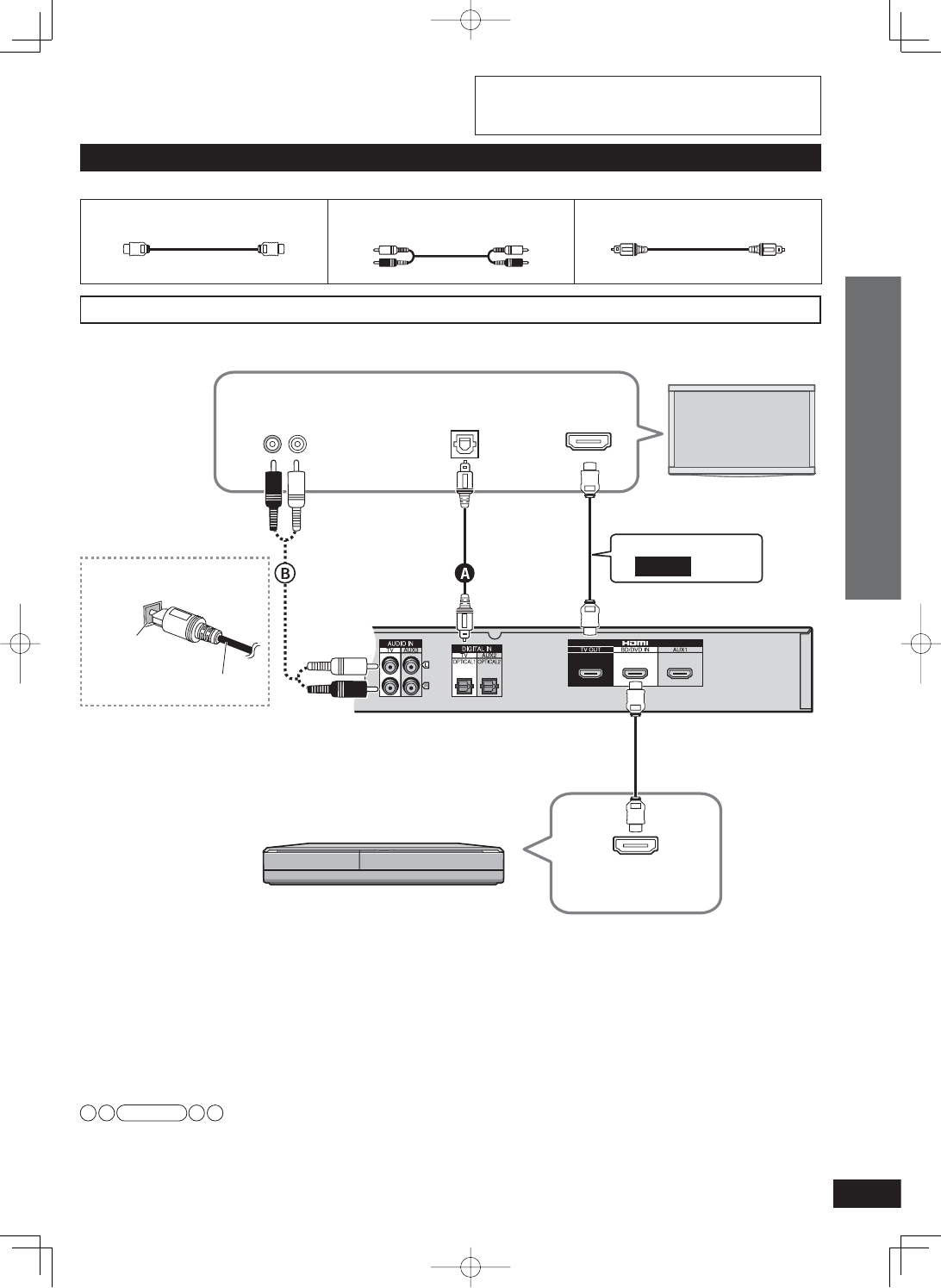
RQT9471
9
Main unit
HDMI
input
TV
HDMI
Video/Audio
out
HDMI cable notes
• It is recommended that you use Panasonic’s HDMI cables.
• Please use High Speed HDMI Cables that have the HDMI logo (as shown on the cover).
• When outputting 1080p signal, please use the HDMI cables 5.0 meters (16.4 feet) or less.
Enjoying only with TV speaker
• When image equipment such as TV and Blu-ray Disc player/DVD recorder, etc. is connected to HDMI terminal (➜ above, page 12)
of this system, images/audio signals from the Blu-ray Disc player/DVD recorder, etc. go through this system and are transmitted to
TV even if this system is turned off using the power button of this system. (Standby through function) This is convenient to enjoy
only with TV speaker.
• Images recorded with x.v.Color or Deep Color (➜ page 28) are also supported.
Note
When you turn this system off using the power button of this system, the audio/video signals from equipment connected to HDMI
input are output through the television, even if you have set input on this system to anything other than HDMI input (“BD/DVD ” or
“AUX 1 ”) before turning off this system. (The selector returns to the previous setting when you turn this system on again.)
When equipment is connected to both BD/DVD IN terminal and AUX1 terminal, images/audio signals of equipment whose input is
lastly selected are output.
Connecting the optical
fi ber cable
Insert the cable
so its shape fi ts
correctly into
the terminal. Do not bend!
Digital audio
out (optical)
Blu-ray Disc player/
DVD recorder, etc.
Audio out
R L
If connection is not possible, make connection . When both are
already connected, connection takes priority over connection .
Home Theater connections
• Turn off all equipment before making any connections.
• To connect equipment, refer to the appropriate operating
instructions.
Home Theater connections Connection
Basic connections
Connecting equipment with HDMI terminal (TV, DVD recorder, etc.)
HDMI cable (not included) Stereo connection cable
(not included)
Optical fi ber cable (not included)
Connection cable
Make sure to connect
to TV OUT .
5%<622436;'PKPFF
5%<622436;'PKPFF
ඦ೨
ඦ೨
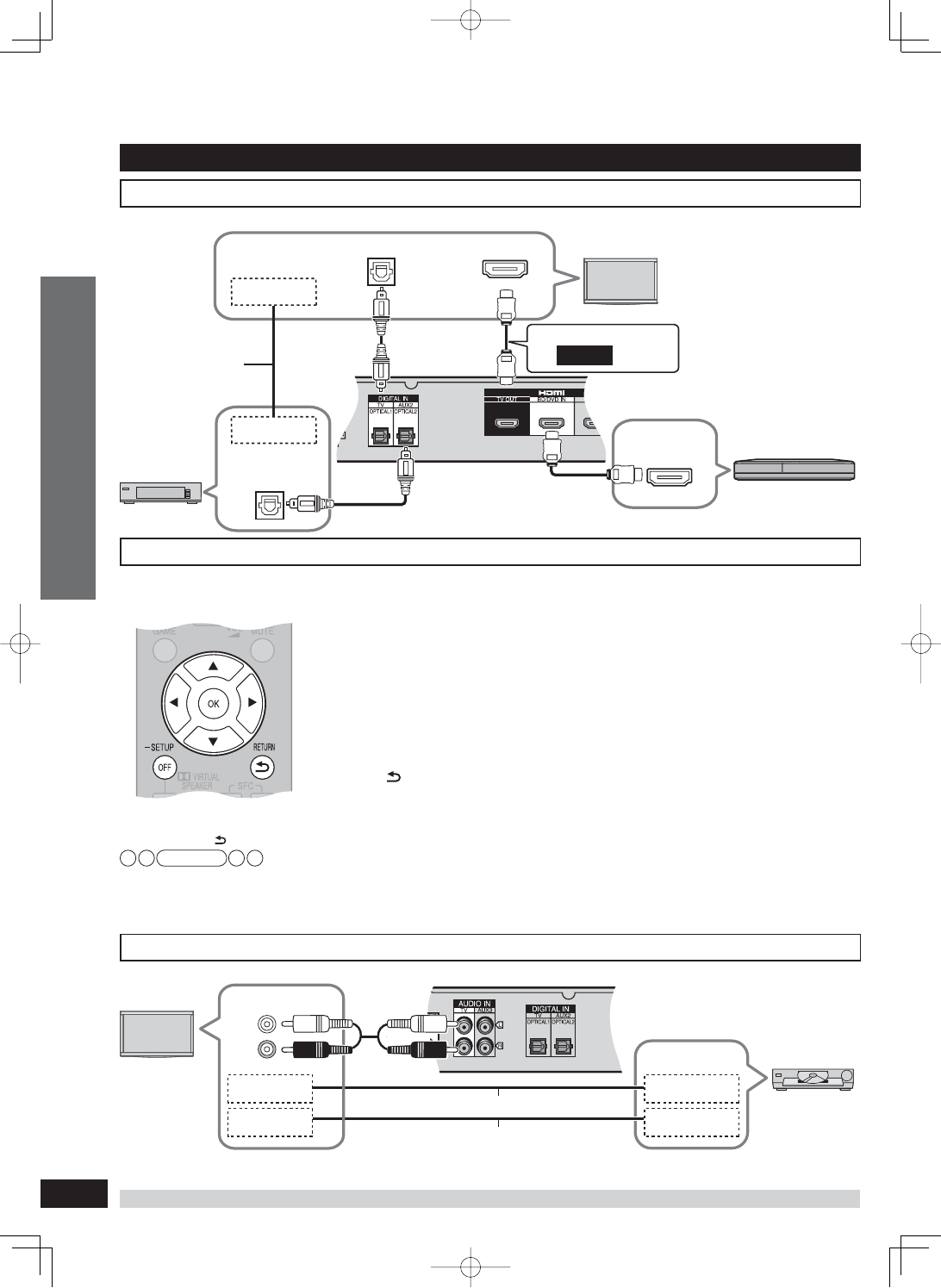
RQT9471
10
Home Theater connections
Home Theater connections Connection
Basic connections
Connecting STB etc.
Use this connection to enjoy STB multi-channel sources on this system.
Main unit
HDMI input TV
HDMI Video/
Audio out
Digital audio out (optical)
Blu-ray Disc player/
DVD recorder, etc.
Make sure to connect
to TV OUT .
Digital audio
out (optical)
STB etc.
Setting for automatically switching the input source to STB
When you make the above connection and you use Panasonic TV (VIERA), you can automatically switch this system’s input by
switching the input source of TV (VIERA) to STB in the following procedure.
Preparation: Make sure that this system has been turned on. (➜ page 16)
1. Switch the input source of TV (VIERA) with the above connection
and show STB pictures.
2. Press and hold [–SETUP, OFF] for about 2 seconds.
The setting items are displayed. (➜ page 21)
3. Press [w][q] to select “STB AUDIO ” and press [OK].
4. Press [e][r] to select “SET ” and press [OK].
SET : The setting is automatically switched to “AUX2 / STB ”.
OFF : The setting is not automatically switched to “AUX2 / STB ”. (factory setting)
5. Press [ RETURN] several times to select “EXIT ” and press [OK]
to fi nish the setting.
:Connect the video cable directly from the other equipment to the television.
:
Use this connection so audio from the equipment can be heard through the television’s speakers even if this system is in standby mode.
Reduce the volume on the television and select “TV ” after you have made connections as above if you want to use this system.
Connecting cables to audio terminals (DVD player, etc.)
TV Audio out
Video cable ()
Audio cable ()
VIDEO IN
AUDIO IN
VIDEO OUT
AUDIO OUT
L
R
Main unit
DVD player
etc.
Note
• “STB AUDIO ” in step 3 is displayed only when the unit is connected to the Panasonic TV (VIERA).
Also, this is not displayed when the step 1 operation is not performed.
• If you change the connection after setting, select OFF once and SET again.
• When you select “EXIT ” and press [OK], the setting mode finishes in step 3.
HDMI IN
HDMI OUT
To return to the previous display/To
cancel during setting operation in
steps 2 to 5: Press [ RETURN].
HDMI cable
• Refer to the operating instructions for the equipment you are connecting for the correct type of video cable.
5%<622436;'PKPFF
5%<622436;'PKPFF
ඦ೨
ඦ೨
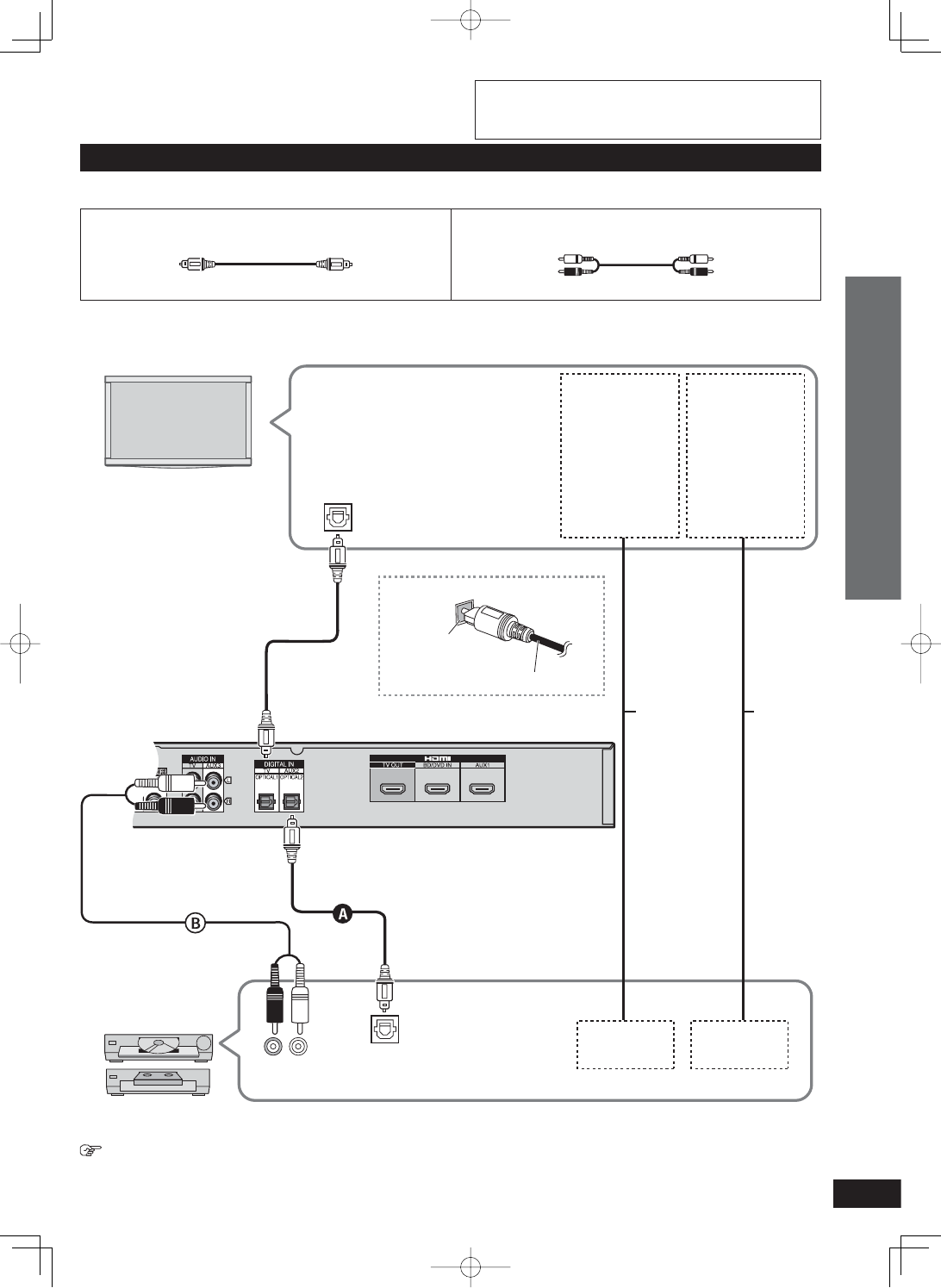
RQT9471
11
Optical fi ber cable (not included) Stereo connection cable
(not included)
• For the correct type of video cable, refer to the operating instructions for the equipment you are connecting.
Connecting equipment without HDMI terminal (DVD player, VCR, etc.)
Connection cable
Connecting the optical fi ber cable
Insert the cable so
its shape fi ts correctly
into the terminal. Do not bend!
Make the connection either or according to the suitability for your equipment.
To connect a DVD recorder with built-in VCR
(When the DVD recorder has DVD output terminal and DVD/VHS output terminal, make the following connections.)
Make the above connection for DVD output terminal.
Make the above connection for DVD/VHS output terminal.
TV
Digital audio
out (optical)
Connect the video
cable directly
from the other
equipment to the
television.
Use this connection
so audio from the
equipment can
be heard through
the television’s
speakers even if
this system is in
standby mode.
Main unit
Video
cable
Audio
cable
DVD player,
VCR, etc.
R L
Audio out
Digital audio
out (optical)
VIDEO OUT AUDIO OUT
VIDEO IN AUDIO IN
• Turn off all equipment before making any connections.
• To connect equipment, refer to the appropriate operating
instructions.
Home Theater connections Connection
5%<622436;'PKPFF
5%<622436;'PKPFF
ඦ೨
ඦ೨
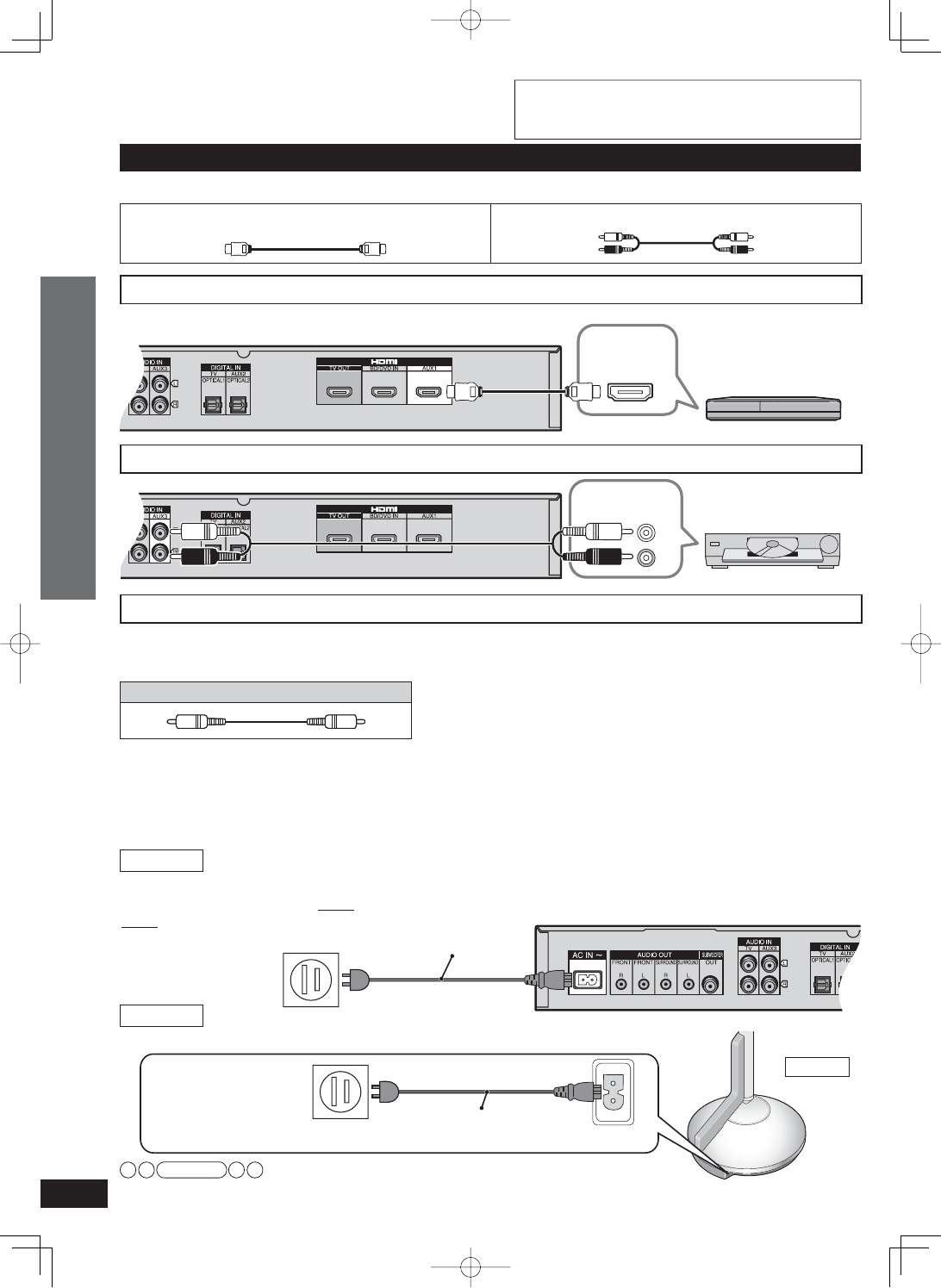
RQT9471
12
For power consumption of speaker, see page 14.
Other connections
AC power supply connection
Connection cable
HDMI cable (not included) Stereo connection cable (not included)
To connect a second set of equipment that supports HDMI
✽ See page 9 for connecting this system to TV.
Main unit HDMI
Video/Audio
out Blu-ray Disc player/
DVD recorder, etc.
To connect audio equipment (CD player, etc.)
Main unit
Audio out
CD player etc.
L
R
To connecting a subwoofer (not included)
You can connect a commercially available active subwoofer (with built-in amplifi er) (not included) to the subwoofer output
terminal (➜ page 6) if you want to enjoy deeper bass sounds.
Connection cable
Monaural connection cable (not included)
Home Theater connections
Main unit
Connect AC power supply cord after all other cables are connected.
This system consumes approx. 0.5 W when AC power supply cord is connected to the household AC outlet (approx.
0.2 W in standby condition (HDMI off mode) (➜ page 22)).
Household AC outlet
(AC 120 V, 60 Hz)
AC power supply cord (included)
AC IN 㨪
Side view
Household AC outlet
(AC 120 V, 60 Hz)
AC power supply cord
(included)
To save power when the system is not to be used for a long time, unplug it from the household AC outlet.
Make sure to turn this system off before unplugging the AC power supply cord.
If you unplug the AC power supply cord without turning this system off, some of the settings may not be saved.
Speakers
Home Theater connections/AC power supply connection Connection
• Turn off all equipment before making any connections.
• To connect equipment, refer to the appropriate operating
instructions.
Note
• The included AC power supply cords are for use with this system only. Do not use them with other equipment.
Also, do not use AC power supply cord for other equipment with this system.
5%<622436;'PKPFF
5%<622436;'PKPFF
ඦ೨
ඦ೨
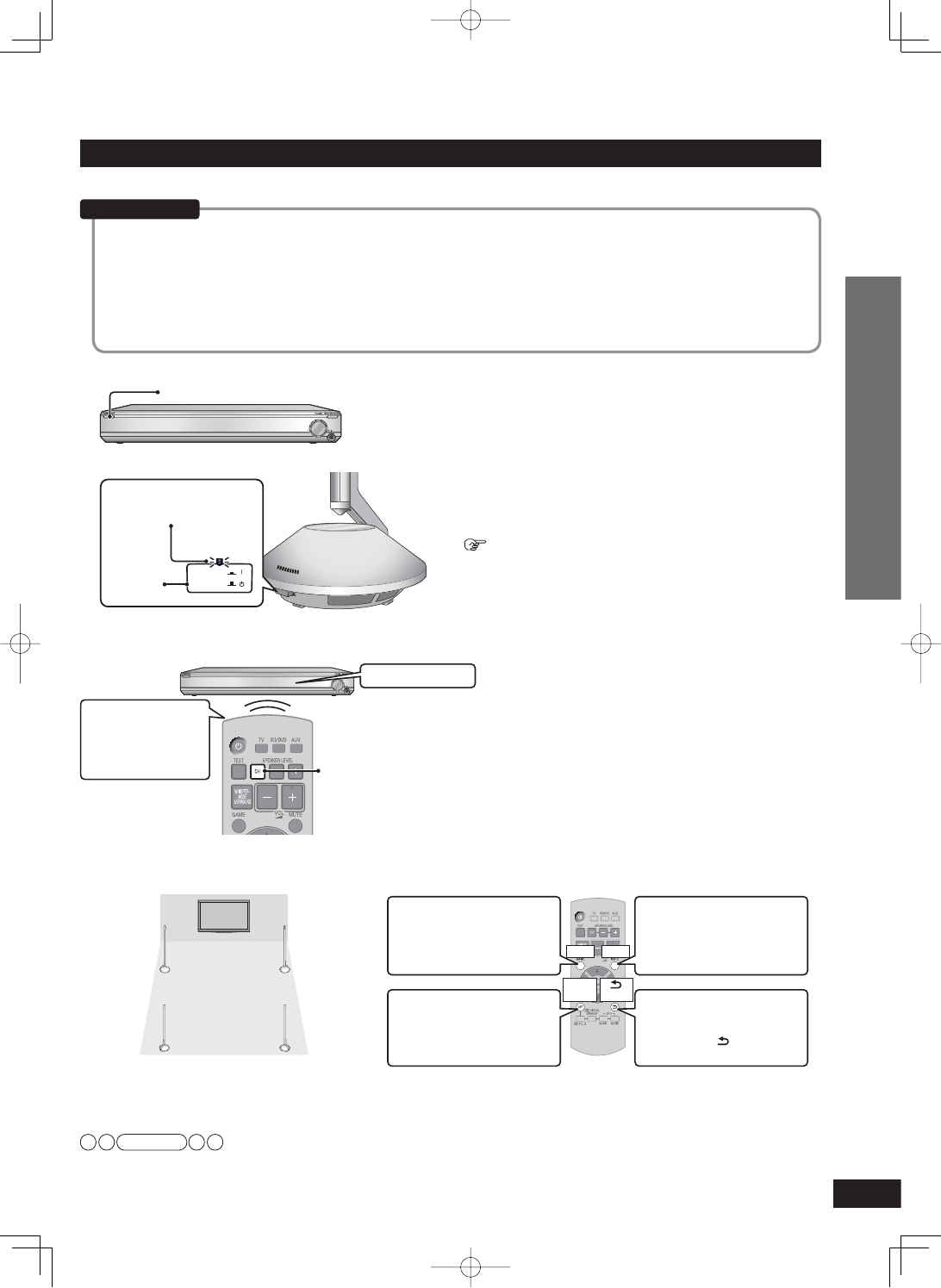
RQT9471
13
1. Turn the main unit on.
Press • “4CH SEARCH ” appears on the display.
(This is displayed only at the first-time setting.)
2. Turn 4 speakers on.
[WIRELESS LINK]
indicator
Press
WIRELESS LINK
POWER
• The color of [WIRELESS LINK] indicator changes from red to
green.
• When the [WIRELESS LINK] indicator of each speaker lights
green, “4CH SEARCH ” display disappears.
3. Press and hold [CH] on the remote control for about 3 seconds until “4 SPKR SET ” is
displayed on the main unit’s display.
Always aim the
remote control at
the main unit for
operation. Press and hold
(about 3 seconds)
“4 SPKR SET ”
4. Press the remote control button corresponding to the speaker outputting the confi rmation
sound.
When the sound is output
from the surround speaker
(right), press [ RETURN].
When the sound is
output from the surround
speaker (left), press
[–SETUP, OFF].
When the sound is
output from the front
speaker (left),
press [GAME].
When the sound is output
from the front speaker
(right), press [MUTE].
Front speaker
(left)
Front speaker
(right)
Surround
speaker (left)
Surround
speaker (right)
GAME MUTE
RETURN
–SETUP,
OFF
• Sound is output from either of the speakers.
• When you press the button corresponding to the confi rmation sound of speaker, another speaker outputs confi rmation sound.
Press the corresponding button in the same way and complete settings for all 4 speakers.
• When “COMPLETE ” disappears on the main unit’s display, the speaker setting is complete.
Note
• Check if the speakers are properly set after setting the speakers. (➜ page 14)
• If the speakers are set incorrectly in step 4, turn the main unit off then on again and perform steps 3 and 4.
• If [WIRELESS LINK] indicator does not change from red to green, see page 27 of “Troubleshooting guide”.
Speaker setting
Make sure that all equipment has been turned off.
(When the VIERA Link “HDAVI Control” compatible Panasonic TV (VIERA) and Blu-ray Disc player/DVD recorder (DIGA) are
connected, do not turn on TV (VIERA) and Blu-ray Disc player/DVD recorder (DIGA) until the setting is complete.)
Connect the AC power supply cords of main unit and 4 speakers to household AC outlets.
(➜ page 12)
Make sure that the main unit and speakers have been turned off.
Prepare the remote control. (➜ page 7)
Preparations
Make sure to make this setting when using for the fi rst time after purchase.
Setting the speakers
Speaker setting Connection
When installing front speakers only
See “Setting front speakers only” (➜ page 15).
5%<622436;'PKPFF
5%<622436;'PKPFF
ඦ೨
ඦ೨
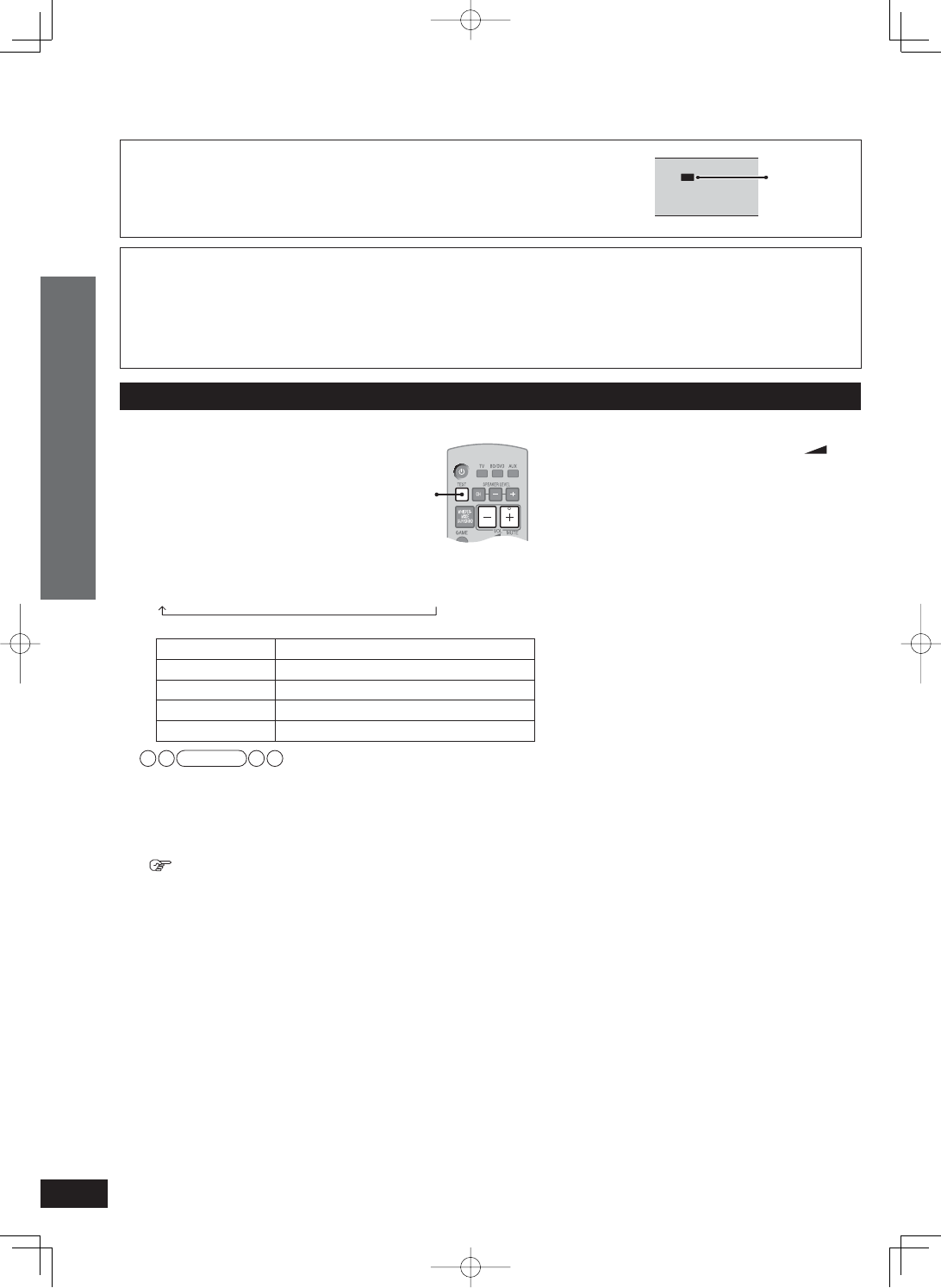
RQT9471
14
When the speakers are detected, the Wireless Link display lights up on the main unit’s
display.
(Blinks during detecting operation.)
While the wireless speakers operate normally, the Wireless Link display lights, but when radio
waves are interrupted (When speakers are in standby condition, etc.), it blinks.
Display
W
Wireless Link
display
Checking the speaker setting
1. Turn the main unit on.
2. Press [TEST] on the remote
control to output the test signal.
3. Make sure that the display of main unit matches speaker locations.
The test signal is output from one speaker at a time for about 2 seconds in the order shown below.
“TEST L ”→ “TEST R ”→ “TEST RS ”✽→ “TEST LS ”✽
Confi rm the correct setting locations in the following chart.
Display Speaker outputting the test signal
TEST L Front left
TEST R Front right
TEST RS ✽Surround right (right back)
TEST LS ✽Surround left (left back)
Note
If the speakers are not properly set, do either of the following.
• Move the speakers according to the unit’s display.
• Perform steps 3 and 4 of “Setting the speakers” (➜ page 13). When using only front speakers, perform steps 4 and 5 of
“Setting front speakers only” (➜ page 15).
4. Press [TEST] on the remote control to stop the test signal.
If the speaker is repaired or replaced
Perform the above “Checking the speaker setting” to confi rm that the speaker properly operates.
Do the following operations if the sound is not produced normally.
1. Press and hold [INPUT SELECTOR] on the main unit about 3 seconds until “4CH SEARCH ” is displayed.
2. Perform steps 2 to 4 of “Setting the speakers” (➜ page 13).
Speaker setting
• When you turn the main unit off with the speakers on, the speakers automatically enter standby (Wireless link standby). The
color of [WIRELESS LINK] indicator turns to red.
• To reduce more of the power consumption of speakers in standby, turn the speakers off. The speakers enter standby (In standby
condition).
<Power consumption of speakers in standby>
Wireless link standby: approx. 0.8 W (for 1 speaker)
In standby condition: approx. 0.1 W (for 1 speaker)
✽ This is not displayed
when using the front speakers only.
Speaker setting Connection
Press
• To adjust the speaker volume, press [VOL +, –].
5%<622436;'PKPFF
5%<622436;'PKPFF
ඦ೨
ඦ೨
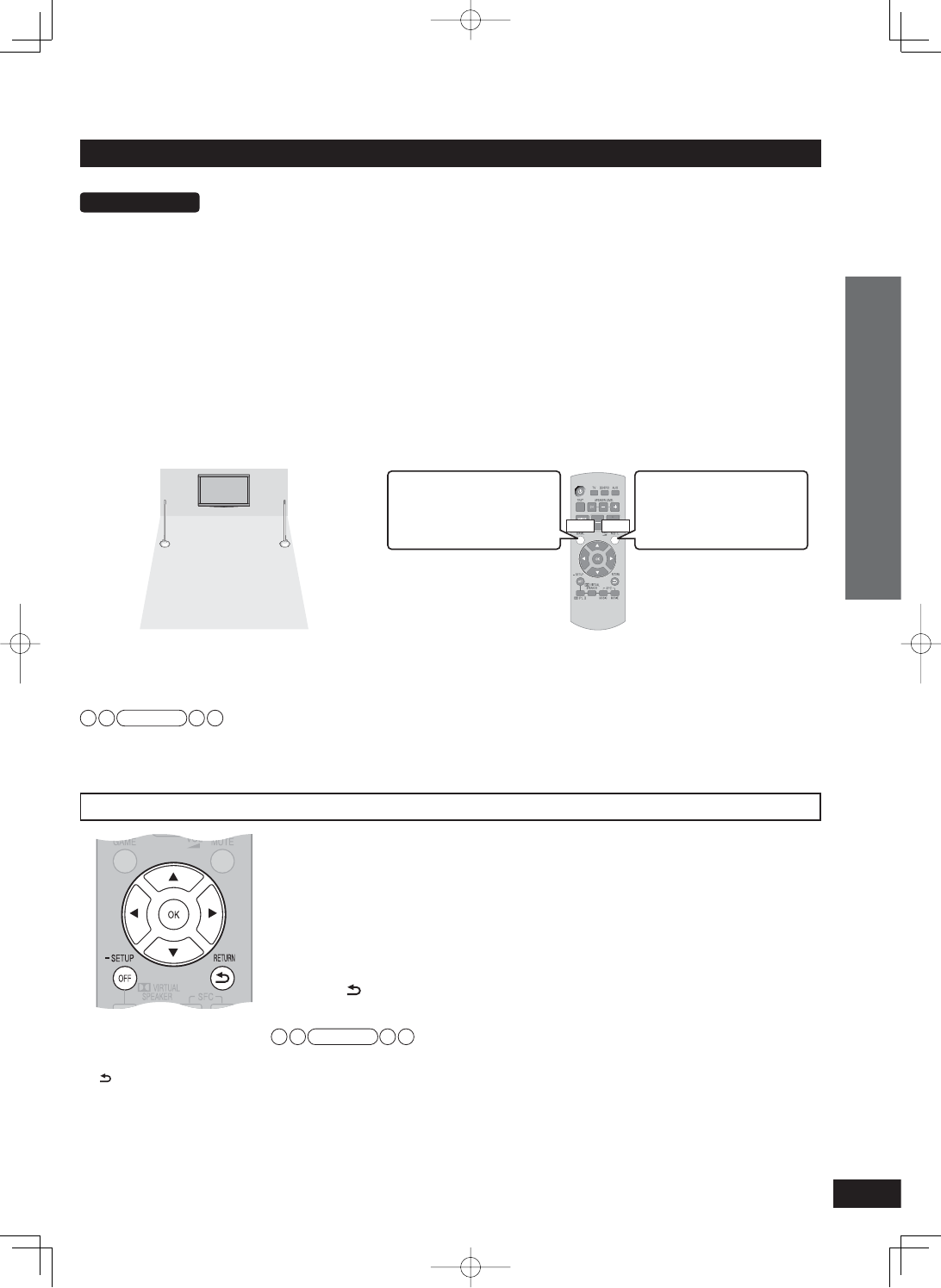
RQT9471
15
Setting front speakers only
Make this setting after the speaker setting on page 13 is complete.
Preparations
• Make sure that all equipment has been turned off.
(When the VIERA Link “HDAVI Control” compatible Panasonic TV (VIERA) and Blu-ray Disc player/DVD recorder (DIGA) are
connected, do not turn on TV (VIERA) and Blu-ray Disc player/DVD recorder (DIGA) until the setting is complete.)
• Turn the main unit on. (➜ page 13)
• Turn 2 speakers on. (➜ page 13)
• Prepare the remote control. (➜ page 7)
1. Set “2CH ” at the setting operation of “Changing the number of speakers to 2” below.
2. Turn the main unit off once.
3. Turn the main unit on again.
4. Press and hold [CH] on the remote control for about 3 seconds until “2 SPKR SET ” is
displayed on the main unit’s display.
• Always aim the remote control at the main unit for operation.
5. Press the remote control button corresponding to the speaker outputting the confi rmation
sound.
When the sound is
output from the front
speaker (left),
press [GAME].
When the sound is output
from the front speaker
(right), press [MUTE].
Front speaker
(left)
Front speaker
(right)
GAME MUTE
• Sound is output from either of the speakers.
• When you press the button corresponding to the confi rmation sound of speaker, another speaker outputs confi rmation sound.
Press the corresponding button in the same way and complete settings for all 2 speakers.
• When “COMPLETE ” disappears on the main unit’s display, the speaker setting is complete.
Note
• Check if the speakers are properly set after setting the speakers. (➜ page 14)
• If the speakers are set incorrectly in step 5, turn the main unit off then on again and perform steps 4 and 5.
• If [WIRELESS LINK] indicator does not change from red to green, see page 27 of “Troubleshooting guide”.
Changing the number of speakers to 2
1. Press and hold [–SETUP, OFF] for about 2 seconds.
The setting items are displayed. (➜ page 21)
2. Press [w][q] to select “SPEAKERS ” and press [OK].
3. Press [e][r] to select “2CH ” and press [OK].
2CH : When only front speakers are installed
4CH : When surround speakers are additionally installed (factory setting)
• When changing the number of speakers to 4, select “4CH ” and press [OK].
4. Press [e][r] to select “YES ” and press [OK].
• To cancel, select “NO ”.
5. Press [ RETURN] several times to select “EXIT ” and press [OK]
to fi nish the setting.
Note
When you select “EXIT ” and press [OK], the setting mode fi nishes in step 2.
Speaker setting Connection
To return to the previous
display/To cancel during
setting operation: Press
[ RETURN].
5%<622436;'PKPFF
5%<622436;'PKPFF
ඦ೨
ඦ೨
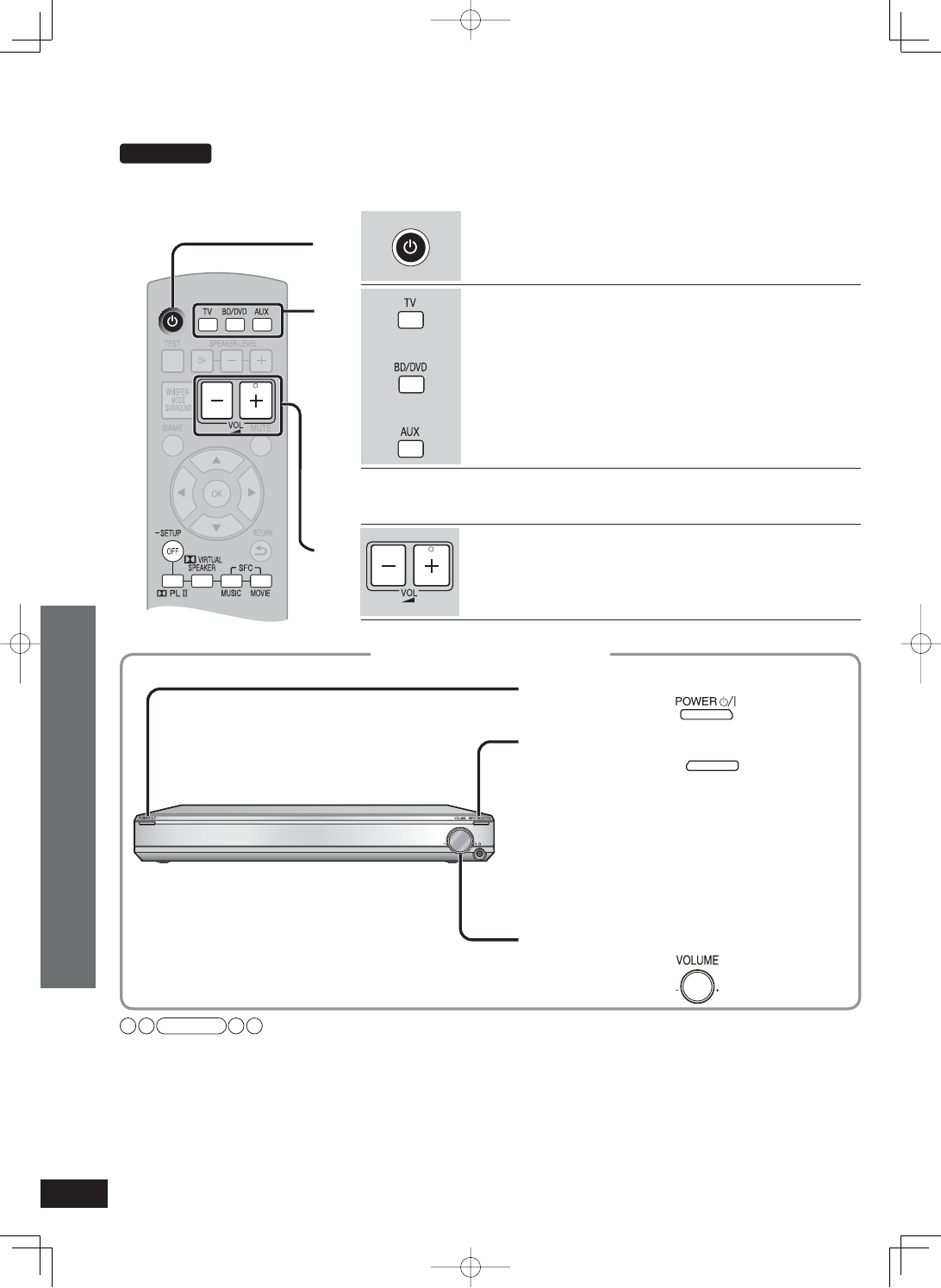
RQT9471
16
•
Turn on the TV and switch its input to match the connection (HDMI, for example) using the TV’s remote control.
•
Make sure that the speakers are on. (The following are operations when the power is on in Wireless link standby.)
Enjoying movies and music
Press
INPUT SELECTOR
1Turn on the system.
Press
(The input source switches each time you
press the button.)
TV : TV (optical, analog)
BD/DVD :
Blu-ray Disc player/DVD recorder (HDMI)
AUX 1 : AUX1 terminal (HDMI)
AUX 2 : AUX2 terminal (optical)
AUX 3 : AUX3 terminal (analog)
Operation on the main unit
2Select the source.
3Start play on the connected
equipment.
4To adjust the volume.
Turn
Note
• See page 27 for digital signals that can be played on this system.
• Depending on the playback signal, you may feel the volume of the bass or surround speakers is not balanced with
the volume of the front speakers. In this case, you can adjust the speaker volume during playback. (➜ page 20)
• Even if you switch input to “TV ”, images (or audio) of the equipment connected to BD/DVD IN terminal or AUX1
terminal are output from TV OUT terminal. When the equipment is connected to both BD/DVD IN terminal and AUX1
terminal, signals of equipment whose input is lastly selected are output.
• When using a DVD recorder with built-in VCR (with the DVD output terminal and DVD/VHS output terminal
mounted), select the input as follows in step 2 above.
To enjoy DVD (when connected to AUX2): select “AUX 2 ”.
To enjoy video (when connected to AUX3): select “AUX 3 ”.
TV : TV (optical,analog)
BD/DVD : Blu-ray Disc player/DVD recorder (HDMI)
AUX 1 : AUX1 terminal (HDMI)
AUX 2 : AUX2 terminal (optical)
AUX 3 : AUX3 terminal (analog)
“AUX 1”,“AUX 2”, and “AUX 3” switch every time you
press [AUX].
Press this button to turn on the system.
1
2
3
4
After playback, reduce the volume level and turn off.
To select the source press one of these
buttons.
Start play on the connected equipment.
You can enjoy a variety of surround effects. (➜ page 17)
To adjust the volume press these
buttons.
or
or
Adjustment range: 0 (Min) to 50 (Max)
Aim the remote control toward the
signal sensor (➜ page 7) on the
main unit of this system.
Preparations
Play Enjoying movies and music
5%<622436;'PKPFF
5%<622436;'PKPFF
ඦ೨
ඦ೨
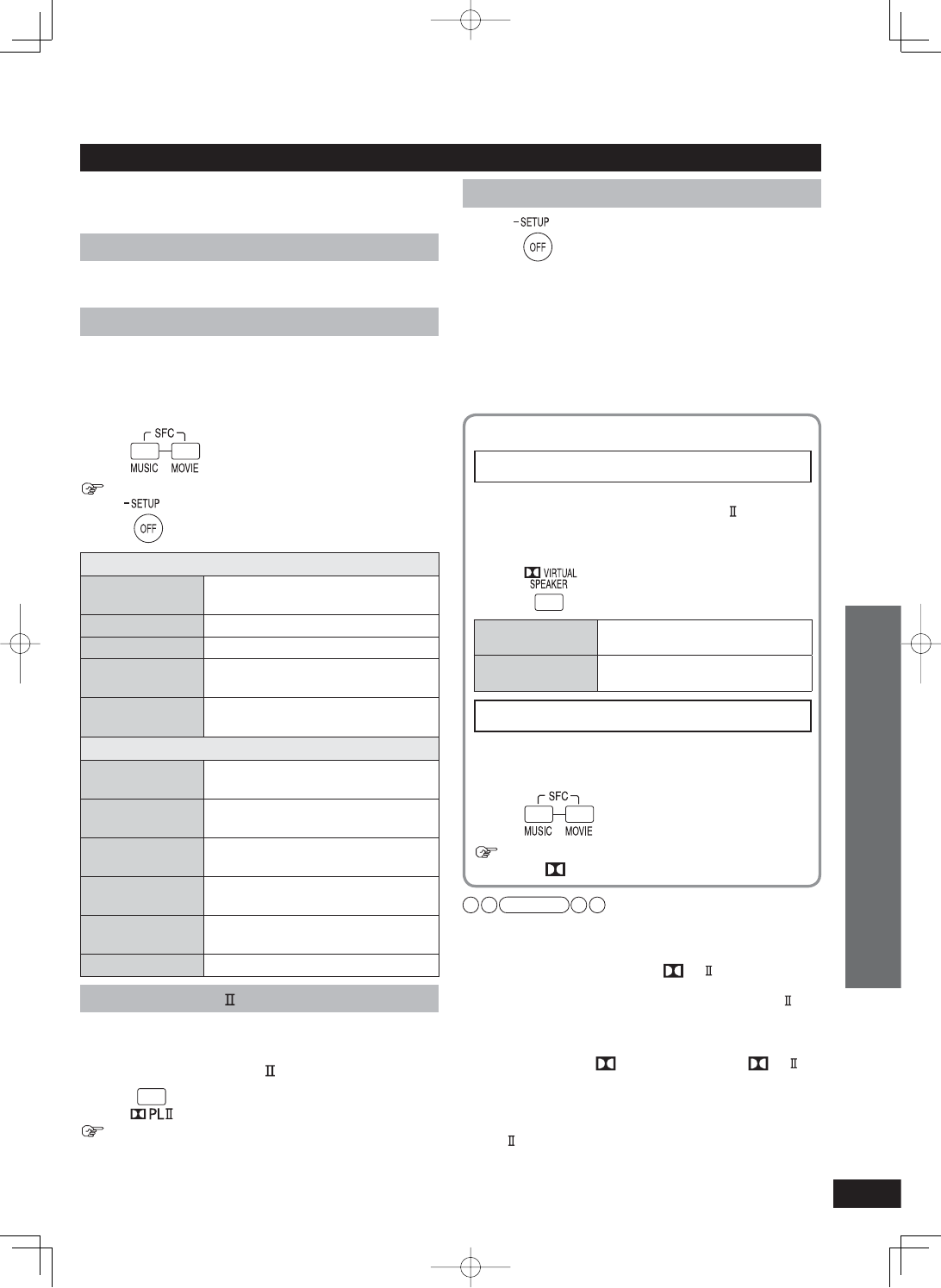
RQT9471
17
Canceling sound fi eld effects
Press
• The surround effects disappear for 2-channel sources such as
CD and TV.
•
When the input signals are multi-channel LPCM or surround digital
signals such as Dolby Digital or DTS, the surround playback (➜ left)
is achieved. When you use front speakers only, those signals are
converged and are output from left and right front speakers.
• The condition before the sound field effect is canceled is
restored when you turn the unit off/on, switch input sources or
plug/unplug the headphones.
Enjoying sound fi eld effects
Sound fi eld effects differ depending on input sources.
Select the mode you prefer after listening to the actual
sound.
Surround playback
Multi-channel signals are distributed to left and right front
speakers, and left and right surround speakers to output.
SFC (Sound Field Control)
You can enjoy more dynamic and broader surround
effects when using SFC with Dolby Digital, DTS and
stereo signals (video, CD, etc.).
Using SFC (Sound Field Control)
Press • The mode switches each time you
press the button. (➜ below)
To cancel SFC mode
Press
MUSIC
LIVE Sound refl ection and spread as if
you were in a large concert hall.
POP/ROCK Best suited for pop and rock music.
VOCAL Enhance vocals.
JAZZ Sound refl ections as if you were in a
small Jazz club.
DANCE Sound spread echoing in a large
space such as a dance hall.
MOVIE
NEWS Best suited for dialogs in news and
drama movies.
ACTION Best suited for action movies with
impact.
STADIUM Enjoy the feeling of being at a live
sporting event.
MUSICAL Enjoy the feeling of being at a live
musical performance.
GAME Enjoy games with greater audio
impact.
MONO Enjoy older monaural audio movies.
Dolby Pro Logic
You can enjoy 2-channel sources such as CD with the
surround effect.
Using Dolby Pro Logic
Press
To cancel sound fi eld effects
Press [–SETUP, OFF]. (➜ right)
Note
• See page 5 about how to display the surround digital signal/
sound field.
• If the input signal is 2-channel, Dolby Virtual Speaker also
works in conjunction by pressing [ PL ]. (Only when not
connecting the surround speakers)
• You cannot use Dolby Virtual Speaker, Dolby Pro Logic and
SFC when the source contains PCM signals with sampling
frequencies of over 48 kHz. They are automatically canceled
if those signals are input. To use the effect when playing back
other sources, press [ VIRTUAL SPEAKER], [ PL ] or
[SFC MUSIC, MOVIE] again to select.
• You can also press [GAME] on the remote control to select
“GAME ” mode (➜ left) of SFC. (➜ page 20)
• When using the surround speakers, Dolby Pro
Logic cannot be used for surround signals such as Dolby
Digital and DTS, and multi-channel LPCM signals.
•
When playing back 7.1-channel LPCM signals, you can enjoy
wider sound field effects as if another speaker is added.
You can make the setting without using this effect. (➜ page 22)
Enjoying movies and music
Play
When using only front speakers
Dolby Virtual Speaker
You can enjoy surround effects as if you were listening
to 5.1 channel sources. (Dolby Pro Logic also works
for stereo signals of video, CD, etc.)
Using Dolby Virtual Speaker
Press • The mode switches each time you
press the button. (➜ below)
REFERENCE
(Standard mode) Standard sound effect.
WIDE (Wide mode) Broadens the effect to the left and
right.
SFC (Sound Field Control) (➜ left)
Using SFC (Sound Field Control)
You can enjoy by adding your favorite surround effect to
the Dolby Virtual Speaker (➜ above) effect.
Press • The mode switches each time you
press the button. (➜ left)
To cancel SFC mode
Press [ VIRTUAL SPEAKER].
5%<622436;'PKPFF
5%<622436;'PKPFF
ඦ೨
ඦ೨
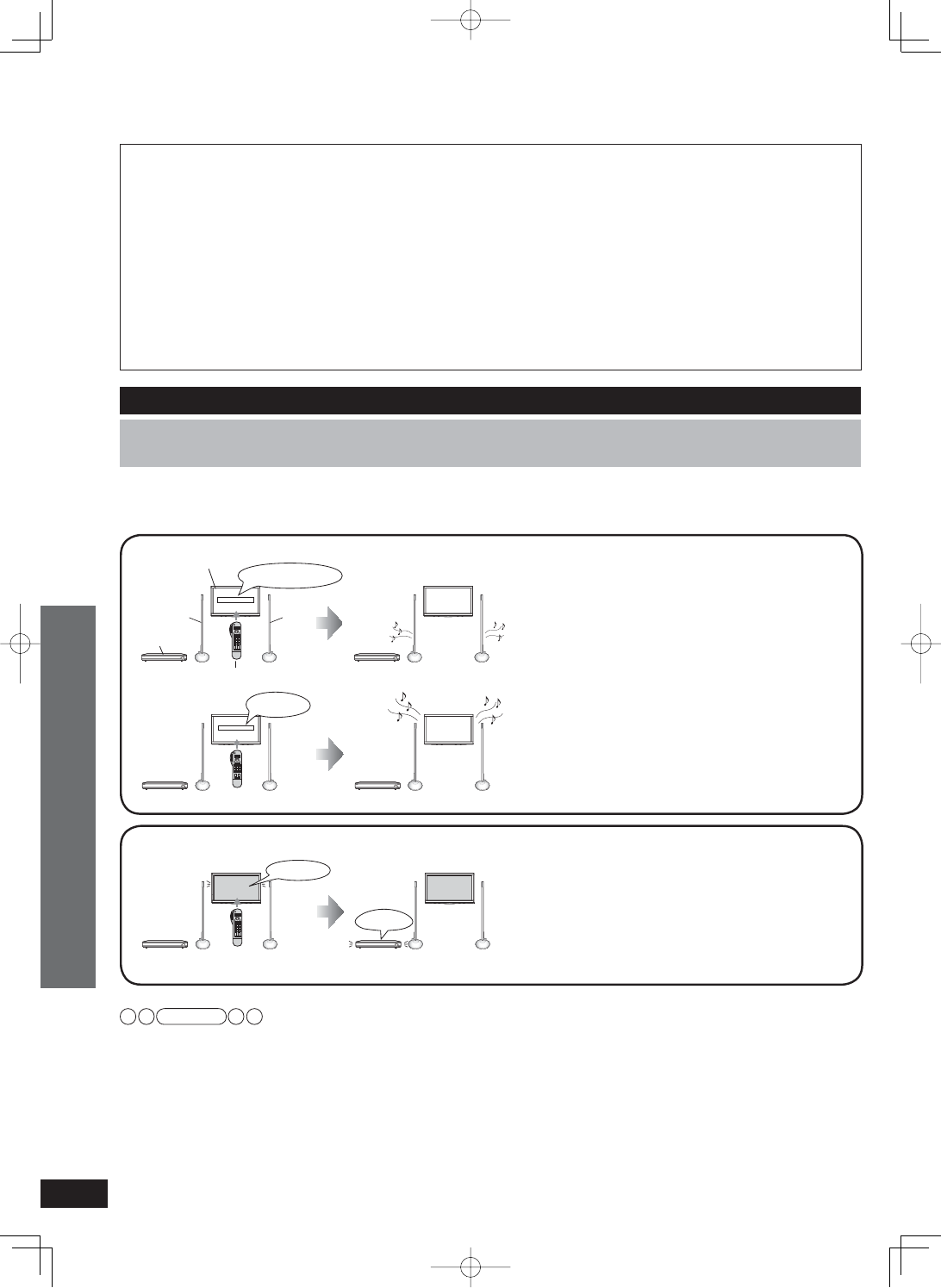
RQT9471
18
What is VIERA Link “HDAVI Control” ?
VIERA Link™ is a new name for EZ Sync
TM
.
VIERA Link “HDAVI Control” is a convenient function that offers linked operations of this system,
and a Panasonic TV (VIERA) or Blu-ray Disc player/DVD recorder (DIGA) under “HDAVI Control”.
You can use this function by connecting the equipment with the HDMI cable. See the operating
instructions for connected equipment for operational details.
• VIERA Link “HDAVI Control”, based on the control functions provided by HDMI which is an industry standard known as HDMI
CEC (Consumer Electronics Control), is a unique function that we have developed and added. As such, its operation with other
manufacturers’ equipment that supports HDMI CEC cannot be guaranteed.
•This system supports “HDAVI Control 4” function.
“HDAVI Control 4” is the newest standard (current as of December, 2008) for Panasonic’s HDAVI Control compatible equipment.
This standard is compatible with Panasonic’s conventional HDAVI equipment.
• Please refer to individual manuals for other manufacturers’ equipment supporting VIERA Link function.
1. You can select “Speaker Selection” (“Home Cinema” or “TV”).
When audio is input, the main unit will be automatically
turned on if it is in standby✽ mode and the sound is
output from this system’s speaker. You can also adjust
the volume level by using the volume control buttons.
✽ “Standby” condition means the condition that the
main unit is off.
TV (VIERA) speakers become active.
When using with the Panasonic TV (VIERA) supporting
HDAVI Control 4 or later version, the main unit is
automatically turned off. (Intelligent Auto Standby)
See operating instructions for TV (VIERA) as well.
TV (VIERA)
Speaker
Main unit
Remote control of TV (VIERA)
Speaker
Home Cinema
TV
2. When you switch off the TV (VIERA), the main unit automatically turns off.
off
off
When the VIERA Link “HDAVI Control” compatible Blu-
ray Disc player/DVD recorder (DIGA) is connected with
an HDMI cable, the Blu-ray Disc player/DVD recorder
(DIGA) also turns off.
Use the remote control of TV (VIERA) for operation. Operations differ depending on the
type of TV.
What you can do with VIERA Link “HDAVI Control”
• The following illustrations and displays are examples, which may differ from the actual product.
• When you do operations other than the following, use this system’s remote control.
• See operating instructions of TV (VIERA) as well.
Using the VIERA Link “HDAVI Control™”
Play Using the VIERA Link “HDAVI Control™”
Note
• When using with Panasonic TV (VIERA) supporting HDAVI Control 4 and later version, when the main unit is turned on, TV
(VIERA) is set to “Home Cinema”.
When using with Panasonic TV (VIERA) supporting HDAVI Control 3 and older version, when the main unit is turned on, “TV
SPEAKER ” is displayed and audio is output from TV (VIERA).
• When using with Panasonic TV (VIERA) supporting HDAVI Control when the main unit is turned off, TV (VIERA) is set to “TV”.
• If you perform operations such as selecting a channel on the remote control of TV (VIERA), this system’s input is switched to “TV ”.
• When you play back the Blu-ray Disc player/DVD recorder (DIGA) etc. connected to BD/DVD IN terminal or AUX1 terminal, this
system’s input is automatically switched to “BD/DVD ” or “AUX 1 ”.
5%<622436;'PKPFF
5%<622436;'PKPFF
ඦ೨
ඦ೨
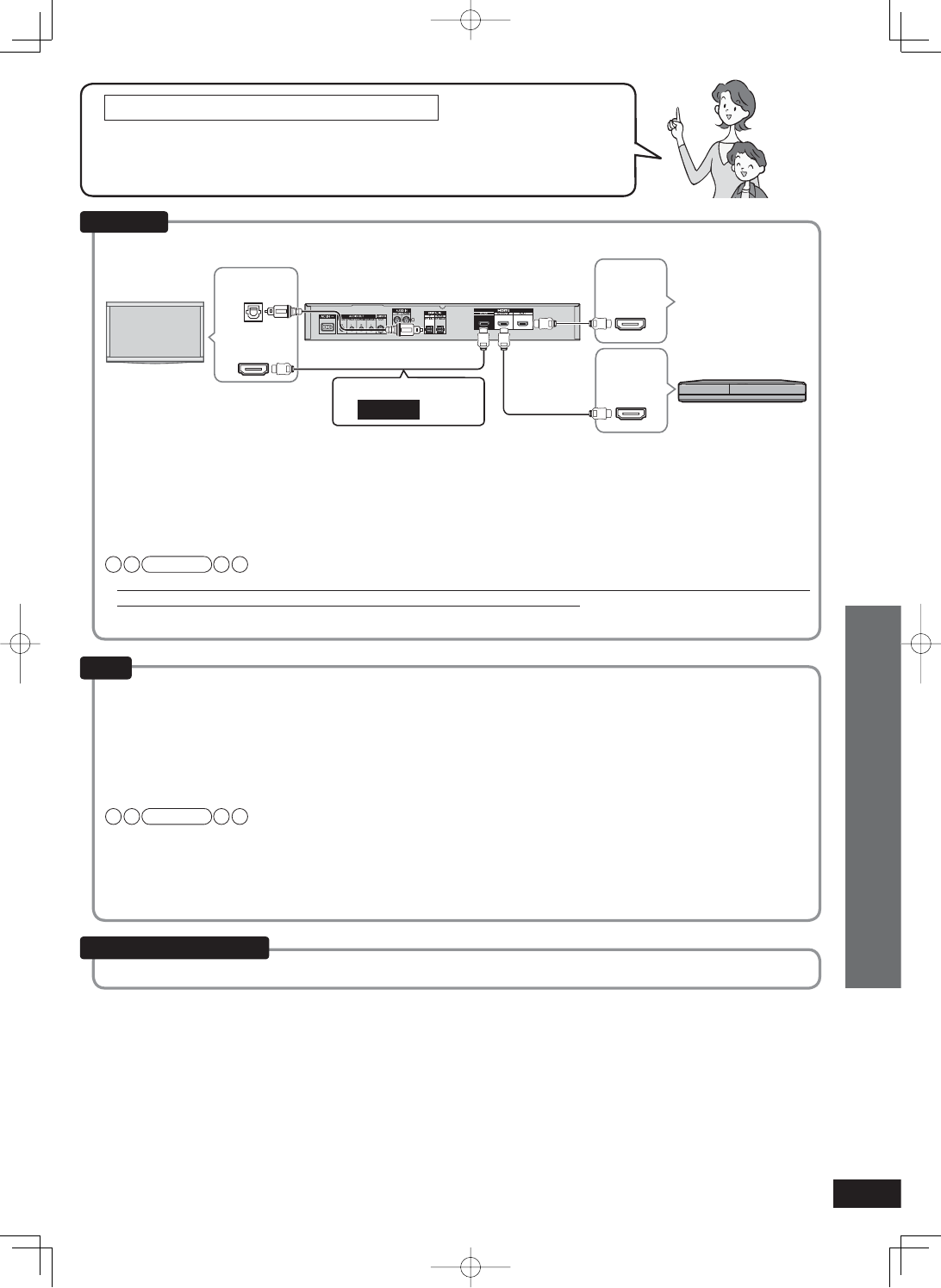
RQT9471
19
For correct use of VIERA Link “HDAVI Control”
Use TV (VIERA)’s remote control to select “Home Cinema” without turning on
the main unit with this system’s power button (including the remote control).
(The main unit is automatically turned on.)
• See operating instructions of TV (VIERA) as well.
Using the VIERA Link “HDAVI Control™”
Play
HDMI cable notes
• Please use High Speed HDMI Cables that have the HDMI logo (as shown on the cover).
• When outputting 1080p signal, please use the HDMI cables 5.0 meters (16.4 feet) or less.
• It is recommended that you use Panasonic’s HDMI cables. (Non-HDMI-compliant cables cannot be utilized.)
Recommended part number: RP-CDHG10 (1.0 m / 3.3 ft.), RP-CDHG15 (1.5 m / 4.9 ft.), RP-CDHG20 (2.0 m / 6.6 ft.),
RP-CDHG30 (3.0 m / 9.8 ft.), RP-CDHG50 (5.0 m / 16.4 ft.), etc.
Note
• Only with HDMI cable connection, you cannot enjoy TV (VIERA) sounds on this system. Connect TV (VIERA) to this system
with the optical fiber cable (or stereo connection cable) to enjoy TV (VIERA) sound.
• See the operating instructions for the TV (VIERA) for VIERA Link “HDAVI Control” operation of connected equipment.
Connect this system with VIERA Link “HDAVI Control” compatible TV (VIERA) and DIGA
Blu-ray Disc player/DVD recorder (DIGA) with an HDMI cable.
Connection
Preparations: Check “VIERA Link “HDAVI Control” setting” (➜ page 23) of this system is “ON ”. Make the
setting to activate VIERA Link “HDAVI Control” function in the menu operation of TV (VIERA).
1. Turn on all equipment other than the TV.
2. Turn on the TV (VIERA).
3. Switch TV (VIERA) input to the HDMI terminal that this system is connected to.
4. Ensure that pictures from the Blu-ray Disc player/DVD recorder (DIGA), etc. are shown correctly after
this system’s input is switched to “BD/DVD ” or “AUX 1 ”.
Note
Make this setting in the following cases:
• when this system is connected for the first time after purchase
• when adding or reconnecting equipment
• when changing the settings for “Reducing standby power consumption (In standby condition (HDMI off mode))” (➜ page 22)
and “VIERA Link “HDAVI Control” setting” (➜ page 23)
Setup
Set “VIERA Link “HDAVI Control” setting” to “OFF ”. (➜ page 23)
When not using this function
Blu-ray Disc
player/DVD
recorder (DIGA)
Main unit
TV (VIERA)
Make sure to connect
to TV OUT .
Digital audio
out (optical)
HDMI input
HDMI
Video/Audio
OUT
HDMI
Video/Audio
OUT
VIERA Link
“HDAVI Control”
compatible
equipment
5%<622436;'PKPFF
5%<622436;'PKPFF
ඦ೨
ඦ೨
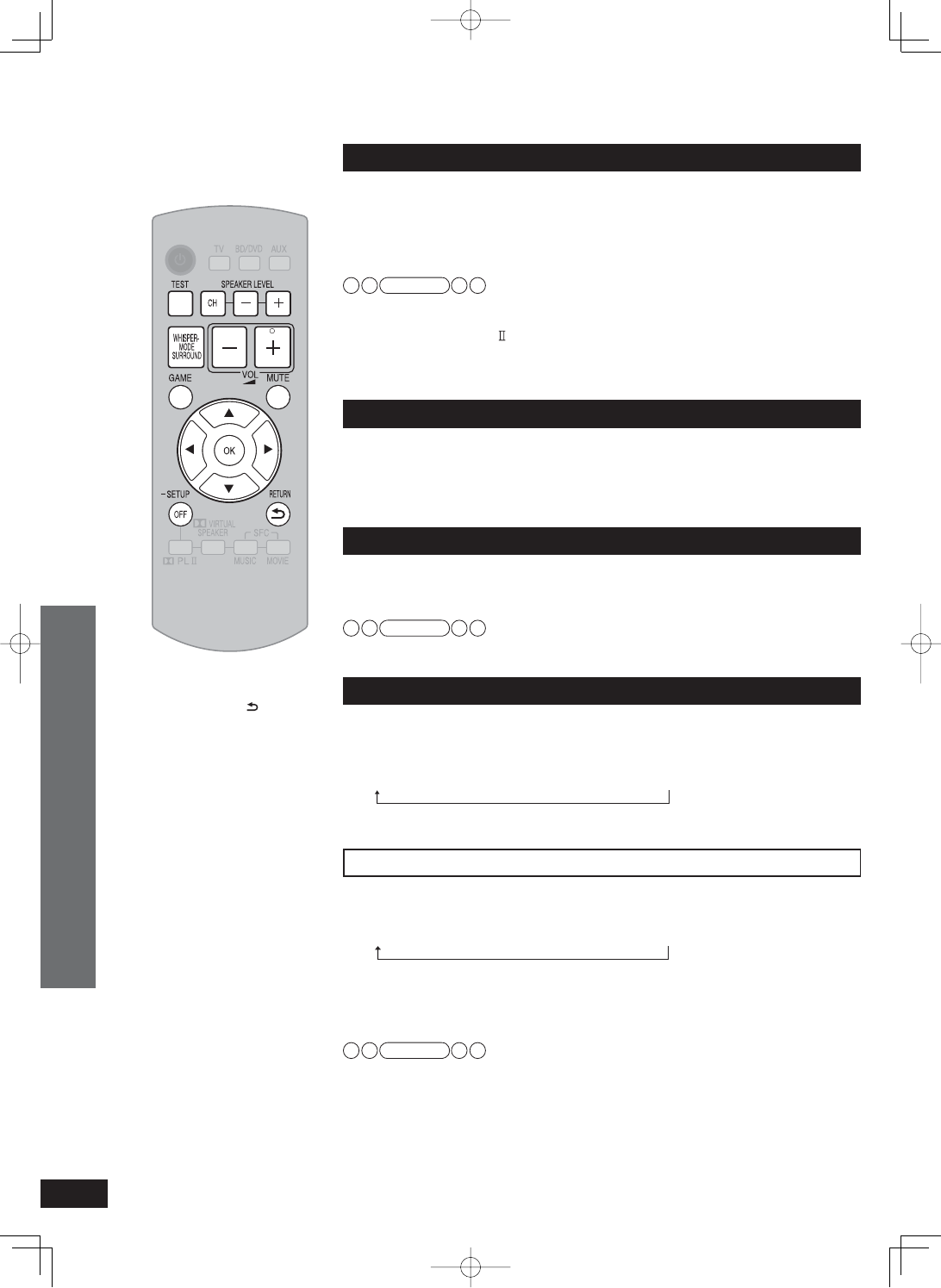
RQT9471
20
Functions and settings
Using “WHISPER-MODE SURROUND”
This function is effective during surround playback only. You can enjoy the dynamic effect
even if the sound volume level is low during surround playback.
Press [WHISPER-MODE SURROUND] to select “W.S. ON ”.
• The current setting is displayed first.
Each time you press, the setting switches between “W.S. OFF ” and “W.S. ON ”.
To cancel Press [WHISPER-MODE SURROUND] to select “W.S. OFF ”.
Note
WHISPER-MODE SURROUND is not effective in the following cases.
When using the surround speakers:
When Dolby Pro Logic and SFC are off with 2-channel signal input
When not using the surround speakers:
When Dolby Virtual Speaker is off
If the above setting is made when this function is on, this function temporarily becomes off.
Using “GAME”
Enjoy gaming with more dynamic sound.
Press [GAME].
• “GAME ” mode (➜ page 17) in SFC is selected.
To cancel Press again.
If canceled, SFC’s effect itself is canceled.
Muting
“MUTE ” blinks on the display while the volume is muted.
Press [MUTE].
To cancel Press again.
Note
• Muting is canceled when you switch the system to standby.
• Muting is also canceled when you adjust the volume.
Adjusting the bass (woofer part) output
When you feel the bass volume is not balanced with the volume of the front speakers, you
can adjust the bass during playback.
1. Press [CH] to select “WFR ”.
(The speaker is switched each time you press the button.)
WFR (woofer) → RS (surround right) (when used) → LS (surround left) (when used)
2. Press [SPEAKER LEVEL +, –] to adjust the bass volume.
Adjustment range: MIN, 1 to 15, MAX
Adjusting the surround speaker output
When using the surround speakers, you can adjust them, too.
1. Press [CH] to select “RS ” or “LS ”.
(The speaker is switched each time you press the button.)
WFR (woofer) → RS (surround right) (when used) → LS (surround left) (when used)
2. Press [SPEAKER LEVEL +, –] to adjust the volume of each
speaker.
Adjustment range: –10 to +10
Repeat steps 1 and 2 to adjust the level of each speaker.
Note
•
You cannot adjust the front speakers with this operation. To adjust the volume balance of left
and right front speakers, see “Adjusting the volume balance of front speakers”. (
➜
page 21)
• If the sound is distorted, lower the level.
• You cannot adjust the output level of speakers if the sound field effect is off and the
speaker’s audio output is set to off. (➜ page 17)
• You can adjust the speaker’s output level in SFC’s each mode respectively. (➜ page 17)
• When a commercially available active subwoofer is connected to the subwoofer output
terminal on this unit’s rear panel, the subwoofer is synchronized with the unit and the
sound volume is adjusted.
To return to the previous display/
To cancel during setting operation
(➜ page 21): Press [ RETURN].
Play Functions and settings
5%<622436;'PKPFF
5%<622436;'PKPFF
ඦ೨
ඦ೨
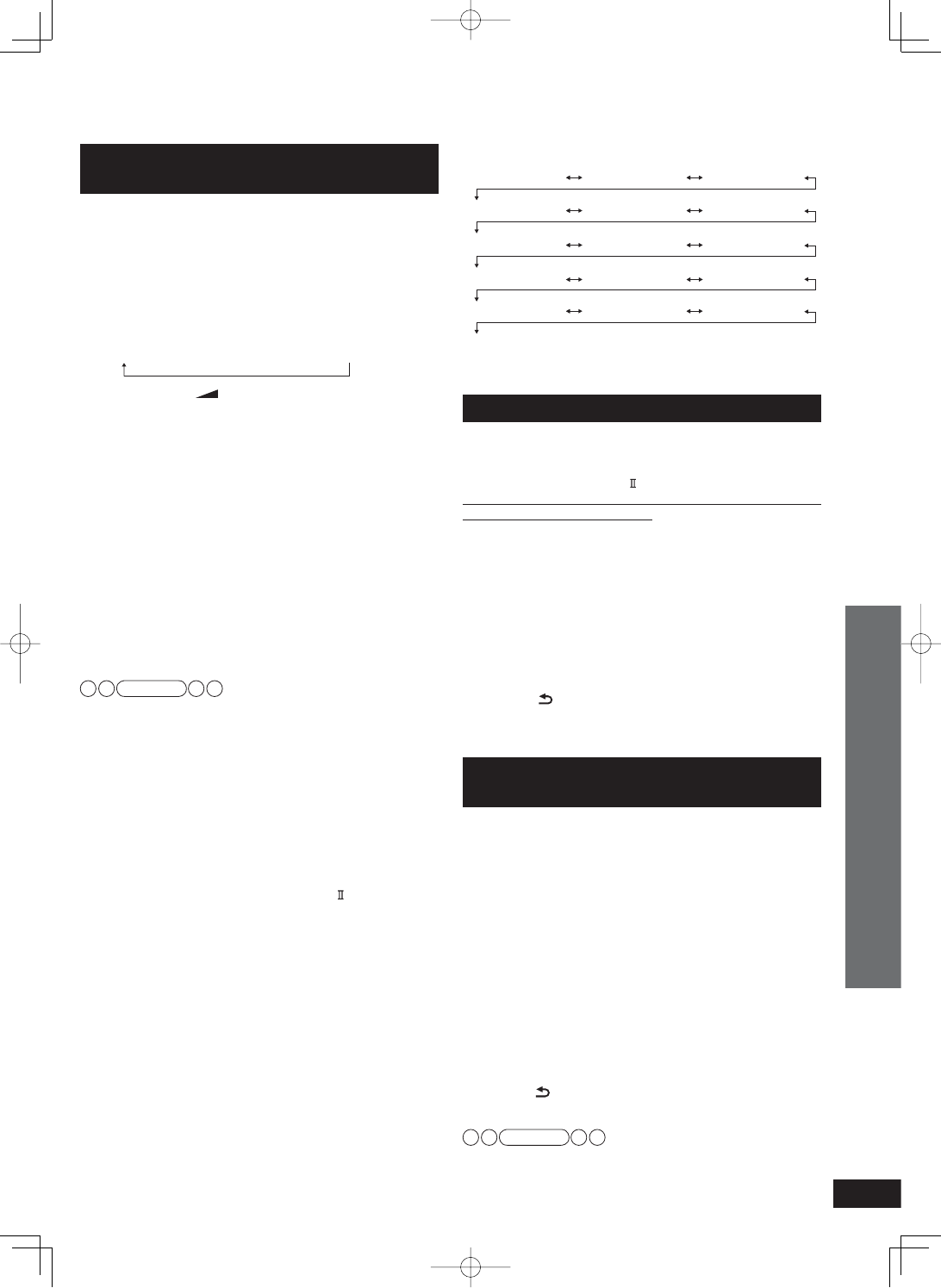
RQT9471
21
Setup menu items
“REMOTE” “
INPUT MODE
” “RESET”
✽“BASS” ✽“TREBLE” ✽“BALANCE”
“SPEAKERS” ✽“DISTANCE”
✽“STB AUDIO”
“7.1CH VS”
“HDMI” “
SOUND DLY
”
“DUAL PRG” “DRCOMP” “
ATTENUATOR
”
“EXIT”
•✽ appears only when audio adjustment can be made.
• Select “EXIT ” and press [OK] to finish the setup mode.
Adjusting sound quality
You can adjust the level of bass and treble.
This setting is effective only when you perform stereo playback
of 2-channel analog and PCM signals (during Dolby Virtual
Speaker and Dolby Pro Logic is off).
This setting is not displayed in other conditions. Be sure to make
this setting in the above condition.
1. Press and hold [–SETUP, OFF] for about
2 seconds.
The setting items are displayed. (➜ above)
2. Press [w][q] to select “BASS ” or
“TREBLE ” and press [OK].
3. Press [e][r] for adjustment, and press
[OK].
Adjustment range: –6 to +6
Factory setting: 0
4. Press [ RETURN] several times to select
“EXIT ” and press [OK] to fi nish the
setting.
Adjusting the volume balance of
front speakers
You can adjust the balance of the front speakers.
1. Press and hold [–SETUP, OFF] for about
2 seconds.
The setting items are displayed. (➜ above)
2. Press [w][q] to select “BALANCE ” and
press [OK].
3. Press [w][q] for adjustment, and press
[OK].
L : Front left
R : Front right
Move the bar to left and right on the display to adjust.
• As the bar gets closer to “L ”, the sound moves to left
front.
• As the bar gets closer to “R ”, the sound moves to
right front.
4.
Press [ RETURN] several times to select
“EXIT ” and press [OK] to fi nish the setting.
Note
• The bar indication is approximate.
• When using headphones, you cannot adjust the volume
balance.
Adjusting the surround speaker
output using the test signal
You can make this setting when using the surround speakers.
You can adjust the surround speaker volume by outputting the
test signal.
1. Press [TEST] to output the test signal.
Speaker display
L : Front left, R : Front right,
RS : Surround right, LS : Surround left
• The test signal is output from one speaker at a time for two
seconds in the following order.
TEST L pTEST R pTEST RS pTEST LS
2. Press [VOL +, –] to adjust the volumes
of front speakers to the normal listening
level.
Adjustment range: 0 (Min) to 50 (Max)
3. Press [CH] to select surround speakers
for adjustment.
4. Press [SPEAKER LEVEL +, –] to adjust
each speaker’s output level.
Adjustment range: RS,LS : –10 to +10
• The test signal comes from the speaker being
adjusted.
• The test signal is output again in the above order 2
seconds after adjustment.
Repeat steps 3 and 4 to adjust the level of each speaker.
5. Press [TEST] to stop the test signal.
Note
• You can check the audio output of the front speakers.
(➜ page 14) (When the surround speakers are not used, only
“TEST L ” and “TEST R ” are displayed and the test signal is
output alternately.)
• To adjust the volume balance of left and right front speakers,
see “Adjusting the volume balance of front speakers”
(➜ right).
• Even if you adjust each channel level in this adjustment, each
channel level setting in each SFC mode (➜ page 17) does
not change.
• When you make this adjustment while using the front
speakers only, Dolby Virtual Speaker functions. When
playing 2-channel sources, Dolby Pro Logic also works in
conjunction. (➜ page 17)
• To adjust the bass volume, do not output the test signal for
adjustment. (➜ page 20)
Functions and settings
Play
5%<622436;'PKPFF
5%<622436;'PKPFF
ඦ೨
ඦ೨
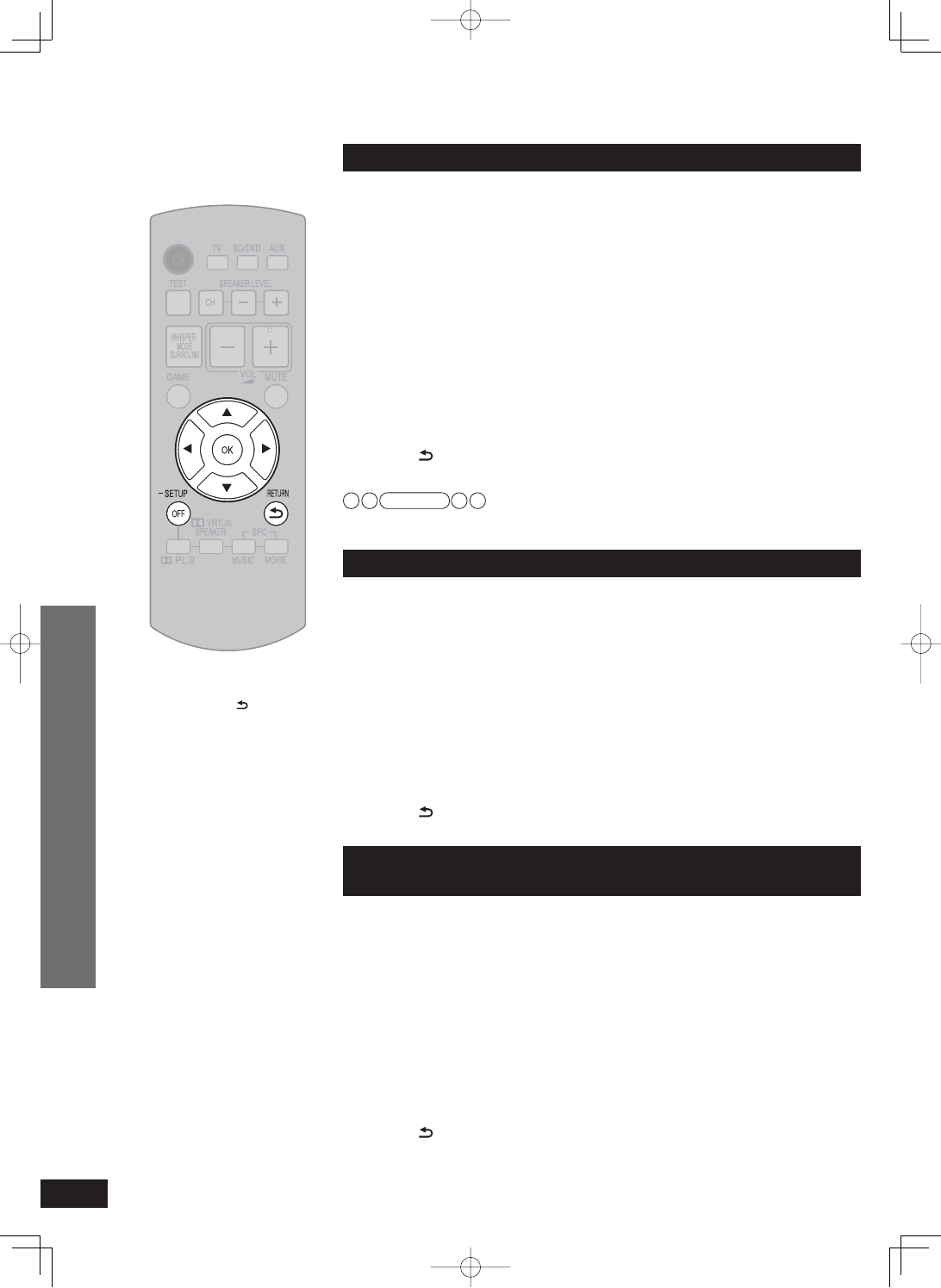
RQT9471
22
Setting distances
You can make this setting when using the surround speakers.
This setting is not displayed under different conditions.
By setting the distance from front/surround speakers to the listening-viewing position, the
sound delay time is automatically calculated and adjusted so that sound reaches the listener
at the same time.
1. Press and hold [–SETUP, OFF] for about 2 seconds.
The setting items are displayed. (➜ page 21)
2. Press [w][q] to select “DISTANCE ” and press [OK].
3. Press [w][q] to select a speaker to set and press [OK].
FRONT : Front speakers
SURR : Surround speakers
4. Press [e][r] to select the distance and press [OK].
Adjustment range: 1.0 to 10.0 meter (3.0 to 30.0 ft (feet))
Factory setting : Front 3.0 meter (10.0 ft (feet))
Surround 1.5 meter (5.0 ft (feet))
5. Press [ RETURN] several times to select “EXIT ” and press
[OK] to fi nish the setting.
Note
Radio waves from this system reach the maximum range of 15 m (49 feet) within the same
room.
Setting 7.1-channel virtual surround
When playing back 7.1-channel LPCM signals, you can enjoy wider sound fi eld effects as if
another speaker is added. Factory setting is “AUTO ”.
When you do not want to use 7.1-channel virtual surround effect, select “OFF ” in this setting.
1. Press and hold [–SETUP, OFF] for about 2 seconds.
The setting items are displayed. (➜ page 21)
2. Press [w][q] to select “7.1CH VS ” and press [OK].
3. Press [e][r] to select “OFF ” and press [OK].
AUTO : The setting is switched between ON and OFF depending on the input
signals.
Only when 7.1-channel LPCM signals are input, 7.1-channel virtual surround
is ON (When other signals are input, this setting is OFF.).
OFF : 7.1-channel virtual surround is always OFF.
Factory setting : AUTO
4. Press [ RETURN] several times to select “EXIT ” and press
[OK] to fi nish the setting.
Reducing standby power consumption
(In standby condition (HDMI off mode))
Standby through function (➜ pages 9, 28) does not work in this mode if you have connected
through the HDMI terminal.
VIERA Link “HDAVI Control” (➜ page 18) will not function when this system is off.
1. Press and hold [–SETUP, OFF] for about 2 seconds.
The setting items are displayed. (➜ page 21)
2. Press [w][q] to select “HDMI ” and press [OK].
3. Press [w][q] to select “STNBY ” and press [OK].
4. Press [e][r] to select “OFF ” and press [OK].
OFF : Standby power consumption reduced
(approx. 0.2 W)
ON : “Standby through” is activated when this system is turned off. (Normal power
consumption)
Factory setting: ON
5. Press [ RETURN] several times to select “EXIT ” and press
[OK] to fi nish the setting.
Functions and settings
To return to the previous
display/To cancel during setting
operation: Press [ RETURN].
Play Functions and settings
5%<622436;'PKPFF
5%<622436;'PKPFF
ඦ೨
ඦ೨
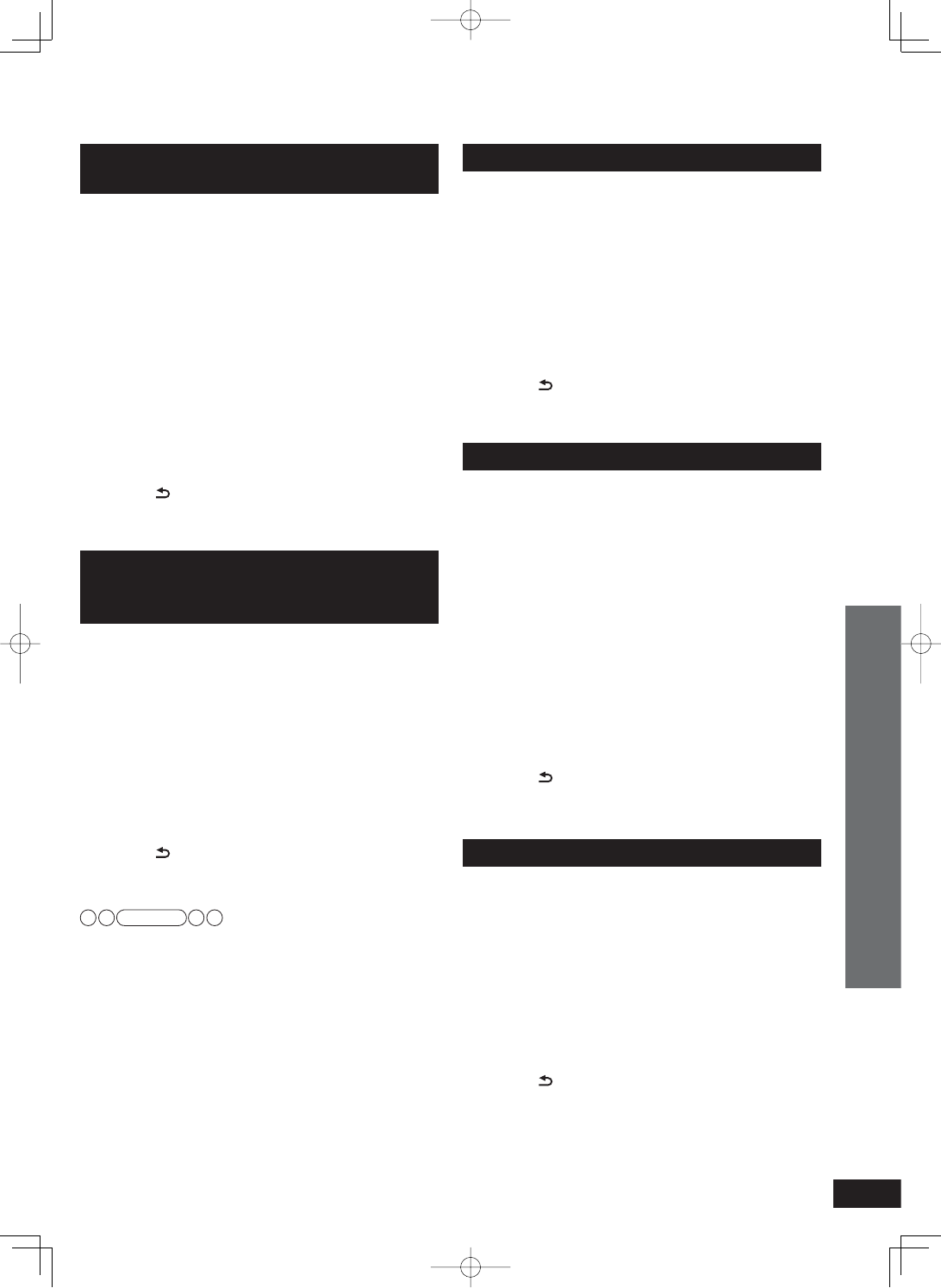
RQT9471
23
Switching between dual sounds
You can switch between dual sounds of Dolby Digital signals.
1. Press and hold [–SETUP, OFF] for about
2 seconds.
The setting items are displayed. (➜ page 21)
2. Press [w][q] to select “DUAL PRG ” and
press [OK].
3. Press [e][r] to select the audio and press
[OK].
MAIN : Main audio SAP : Sub channel audio output
M+S : Main + Sub channel audio output
Factory setting : MAIN
4. Press [ RETURN] several times to select
“EXIT ” and press [OK] to fi nish the
setting.
Clear audio at low volume
Dynamic range compression function for Dolby Digital.
It compresses the dynamic range so that you can still hear
dialog and leave the sound fi eld unaffected.
Use this function when you have to turn the volume down, such
as late at night.
1. Press and hold [–SETUP,OFF] for about
2 seconds.
The setting items are displayed. (➜ page 21)
2. Press [w][q] to select “DRCOMP ” and
press [OK].
3. Press [e][r] to select the setting and
press [OK].
OFF : Normal playback
STANDARD : The best suited playback for each audio
source
MAX : Always compressed at the maximum level
Factory setting : OFF
4. Press [ RETURN] several times to select
“EXIT ” and press [OK] to fi nish the
setting.
Switching the attenuator
Switch the attenuator “ON ” when big sounds become distorted
while playing an analog input source.
1. Press and hold [–SETUP, OFF] for about
2 seconds.
The setting items are displayed. (➜ page 21)
2. Press [w][q] to select “ATTENUATOR ”
and press [OK].
3. Press [e][r] to select “ON ” and press
[OK].
ON, OFF
Factory setting : OFF
4. Press [ RETURN] several times to select
“EXIT ” and press [OK] to fi nish the
setting.
VIERA Link “HDAVI Control”
setting
When you do not wish to use VIERA Link “HDAVI Control”
(➜ page 18), you can set the unlinked operation by selecting
“OFF ”.
The normal setting is “ON ” (Linked operation).
1. Press and hold [–SETUP, OFF] for about
2 seconds.
The setting items are displayed. (➜ page 21)
2. Press [w][q] to select “HDMI ” and press
[OK].
3. Press [w][q] to select “CTRL ” and press
[OK].
4. Press [e][r] to select “ON ” or “OFF ”
and press [OK].
ON : When the operation is linked
OFF : When the operation is not linked
Factory setting: ON
5. Press [ RETURN] several times to select
“EXIT ” and press [OK] to fi nish the
setting.
Adjusting the time lag between
audio and video by delaying
audio output
You can reduce audio and video time lag by adjusting sound
delay.
1. Press and hold [–SETUP, OFF] for about
2 seconds.
The setting items are displayed. (➜ page 21)
2. Press [w][q] to select “SOUND DLY ” and
press [OK].
3. Press [e][r] to select the setting and
press [OK].
AUTO, OFF, 10, 20, 30, 40, 60, 80, 100, 120, 140,160,
180, 200
Factory setting: AUTO
4. Press [ RETURN] several times to select
“EXIT ” and press [OK] to fi nish the
setting.
Note
• If delaying audio output is not necessary, select “OFF ”.
• “AUTO ” is effective only when connecting the Panasonic TV
(VIERA) supporting HDAVI Control 3 and later versions. (Auto
Lip Synchronization Function)
• When you connect the Panasonic TV incompatible with
HDAVI Control 3 and later versions or non-Panasonic TV, if
“AUTO ” is set, “40 ” (msec) is set.
Functions and settings
Play
5%<622436;'PKPFF
5%<622436;'PKPFF
ඦ೨
ඦ೨
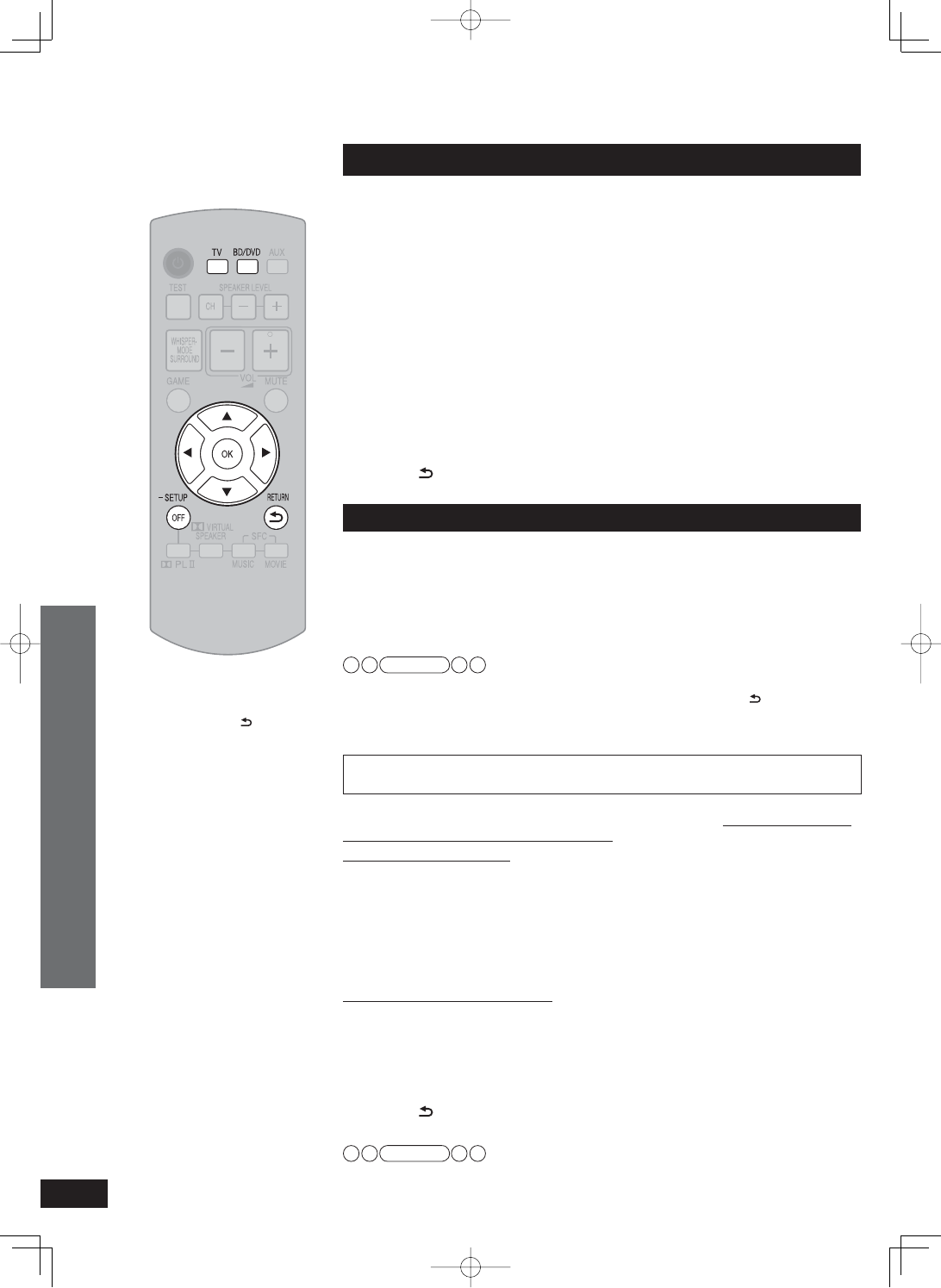
RQT9471
24
Functions and settings
Switching the input signal detection setting
Most sources can be played with “AUTO ” (factory setting).
However, in the following cases, change the input signal detection setting.
• When the beginning of the song is cut during playback of CD, set to “PCM ” (PCM FIX).
• When the signal is not detected during playback of DTS sources, set to “DTS ” (DTS FIX).
• When noise occurs, return the setting to “AUTO ”.
1. Press and hold [–SETUP, OFF] for about 2 seconds.
The setting items are displayed. (➜ page 21)
2. Press [w][q] to select “INPUT MODE ” and press [OK].
3. Press [w][q] to select the input and press [OK].
Input: TV,DVD,AUX1,AUX2
4. Press [e][r] to select the detection method of input signal
and press [OK].
AUTO : Automatic detection
PCM : PCM (from CDs) digital input fi xed
DTS : DTS digital input fi xed
Factory setting : AUTO
Repeat steps 3 and 4 to change setting.
5. Press [ RETURN] several times to select “EXIT ” and press
[OK] to fi nish the setting.
Reset (factory settings)
The operation settings for the system will be initialized to the settings made at the time of shipment.
1. Press and hold [–SETUP, OFF] for about 2 seconds.
The setting items are displayed. (➜ page 21)
2. Press [w][q] to select “RESET ” and press [OK].
3. Press [e][r] to select “YES ” and press [OK].
YES : Choice for resetting NO : Choice against resetting
• To cancel, select “NO ”.
Note
•
All the settings are reset when you select “YES ” and the input selector automatically switches to “BD/DVD ”.
• If you select “NO ”, you will return to step 2. To exit setup mode, press [ RETURN] a few
times to display “EXIT ”, and then press [OK].
• The contents of speaker setting are not reset. However, the contents set at “Changing the
number of speakers to 2” (➜ page 15) are reset.
When other equipment (mini component system, AV amp, etc.) manufactured
by Panasonic operates with the remote control operations of this system
When using this system’s remote control, other equipment may operate. In this case, switch
this system’s remote control code to “REMOTE 1 ”. Do the following to set the same code
number for this main unit and remote control.
Setting the main unit
1. Press and hold [–SETUP, OFF] for about 2 seconds.
The setting items are displayed. (➜ page 21)
2. Press [w][q] to select “REMOTE ” and press [OK].
3. Press [e][r] to select “1” and press [OK].
Factory setting : 2
•
You cannot fi nish the setting mode until the setting on the remote control is changed. Go to step 4.
• To set the remote control code to 2, select “2 ” in step 3 and press [OK].
Setting the remote control
4.
Press and hold [OK], and then press [TV] (more than 2 seconds).
TV: Remote control code 1
BD/DVD: Remote control code 2 (factory setting)
• Select the same number as the code number you have selected in step 3.
• To set the remote control code to 2, press and hold [OK] in step 4, and then press
[BD/DVD] more than 2 seconds.
5. Press [ RETURN] several times to select “EXIT ” and press
[OK] to fi nish the setting.
Note
If different codes are set between the main unit and remote control, the error message
“REMOTE 2 ” or “REMOTE 1 ” is displayed.
To return to the previous
display/To cancel during setting
operation: Press [ RETURN].
Play Functions and settings
5%<622436;'PKPFF
5%<622436;'PKPFF
ඦ೨
ඦ೨
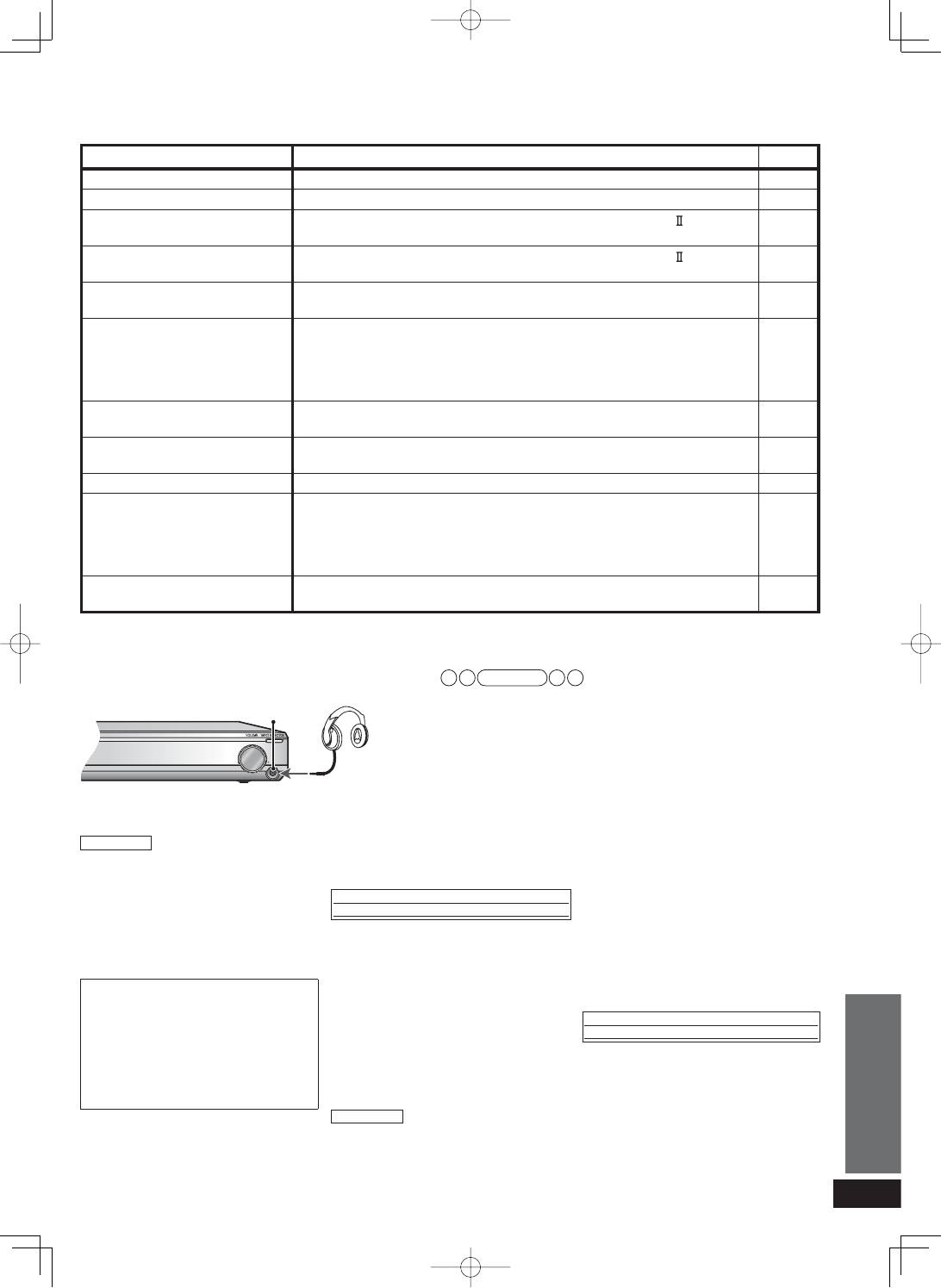
RQT9471
25
Troubleshooting and
other information Error messages/Using with headphones/Specifi cations
Error messages
Display Check point/Cause/Countermeasure Pages
CANCEL MUTE FUNCTION (Scrolling)
• The test signal is not output while muting is on. Cancel muting for operation. 20
MUTE (Blinking) • This is always displayed while muting is on. 20
NOT POSSIBLE FOR
THIS INPUT SOURCE (Scrolling)
• You cannot use Dolby Virtual Speaker, SFC and Dolby Pro Logic for dual
sounds.
—
NOT POSSIBLE FOR
THIS PCM SOURCE (Scrolling)
• You cannot use Dolby Virtual Speaker, SFC and Dolby Pro Logic effect with
PCM signals with sampling frequency of over 48 kHz.
17
NOT POSSIBLE WHEN USING
HEADPHONES (Scrolling) • You cannot use the sound field effects when using headphones. 25
REMOTE 2
REMOTE 1
•
Set the same remote control code for this main unit and remote control. When “REMOTE 2 ”
is displayed, set the code to “2” on the remote control in step 4 of procedure “When other
equipment (mini component system, AV amp, etc.) manufactured by Panasonic operates
with the remote control operations of this system”. When “REMOTE 1 ” is displayed, set the
code to “1” on the remote control in step 4 in the same way.
24
SWITCH OFF POWER
(Scrolling)
•
While
“
F70
”
is displayed, all operations but turning ON/OFF operation are not
available. Turn off the system, unplug the AC power supply cord, and consult your dealer.
—
TURN OFF DTS FIX MODE
(Scrolling)
• When each input is fixed to DTS (DTS FIX), the sound field effects cannot be
canceled even if you press [–SETUP, OFF]. Cancel DTS FIX.
24
U701 •
The equipment connected by the HDMI cable is not compatible with this system’s copyright protection technology
.—
U703
• A problem has occurred with the HDMI connection. Try the following to correct
the problem. Consult your dealer if the error code remains on the display.
– Turn the connected equipment off and on again.
– Disconnect the HDMI cable then reconnect it.
– Do not connect more than 2 sets of equipment to this system’s output.
—
U704 • The system received incompatible video signals through HDMI connection.
Check the settings of the connected equipment.
—
Specifi cations
Using with headphones
Note
• Avoid listening for prolonged periods of time to prevent hearing
damage.
• Multi-channel signals are forcibly converged to 2-channel and
output. (2CH MIX)
However, for DVD audio, the front left and right signals are output.
Turn down the volume as closest as to the minimum value.
• Plug type: 3.5 mm (1/8 in.) stereo mini plug
g PRE AMPLIFIER SECTION
Input sensitivity / Input impedance
TV, AUX3 600 mV / 47 kΩ
S/N ratio (IHF A)
BD/DVD, TV, AUX1,
AUX2 (Digital Input) 80 dB (IHF '66)
Tone controls
BASS 50 Hz, + 6 to –6 dB
TREBLE 20 kHz, + 6 to – 6 dB
Input/Output terminal
Audio Input
Analog Input ( TV, AUX3 ) 2
Optical Digital Input ( TV, AUX2 ) 2
Audio Output
Audio Output ( Front L/R, Surround L/R ) 4
Subwoofer Output 1
Headphone Output ( 16 to 64 Ω ) 1
Video/Audio
HDMI Input ( BD/DVD, AUX1 ) 2
HDMI Output ( TV ) 1
This system supports “HDAVI Control 4” function.
g MAIN UNIT GENERAL
Power supply AC 120 V, 60 Hz
Power consumption 16 W
In standby condition 0.5 W
In standby condition ( HDMI off mode ) 0.2 W
Dimensions ( W x H x D ) 430 mm x 59 mm x 262 mm
(16-15/16" x 2-5/16" x 10-5/16")
Mass [ Weight ] Approx. 2 kg (4.4 lb.)
Operating temperature range 0°C to 40 °C (32°F to 104 °F)
Operating humidity range 20 % to 80 % RH (no condensation)
g WIRELESS SECTION
Frequency of the using band 2.4000 GHz to 2.4835 GHz
Number of using channels 3
The reaching distance 15 m (49 ft)∗1
∗1 It is under the condition as follows.
At same room indoor, there is not an obstacle
between the main unit and the speaker.
And installing a main unit in the position with
equal to or more than 50 cm height.
SPEAKER
g POWER AMPLIFIER SECTION∗2
RMS output power
10 % total harmonic distortion
Woofer Speaker ch 60 W (100 Hz, 3 Ω)
Mid High Speaker ch 20 W (1 kHz, 8 Ω)
System Total Power∗3320 W (80 W x 4)
FTC output power
1.0 % total harmonic distortion
50 Hz to 250 Hz Woofer Speaker ch 37 W (3 Ω)
250 Hz to 20 kHz Mid High Speaker ch 13 W (8 Ω)
System Total Power∗3200 W (50 W x 4)
g SPEAKER SECTION∗2
2 way 5 speakers system (Bass reflex type)
Woofer part 12 cm cone type x 1
Mid High part 2.4 x 10 cm flat type x 4
g SPEAKER GENERAL∗2
Power supply AC 120 V, 60 Hz
Power consumption 20 W
Wireless link standby 0.8 W
In standby condition 0.1 W
Dimensions ( W x H x D ) 290 mm x 1231 mm x 290 mm
(11-13/32" x 48-15/32" x 11-13/32")
Mass [ Weight ] Approx. 3.9 kg (8.6 lb.)
Operating temperature range 0°C to 40°C (32°F to 104°F)
Operating humidity range 20 % to 80 % RH (no condensation)
∗2: per 1 speaker
∗3: use 4 speakers
Note: 1. Specifications are subject to change
without notice.
2. Total harmonic distortion is measured by
the digital spectrum analyzer.
3. Total harmonic distortion is measured by
using AES17 filter.
MAIN UNIT
W (Headphone) jack
Headphones
(not included)
5%<622436;'PKPFF
5%<622436;'PKPFF
ඦ೨
ඦ೨
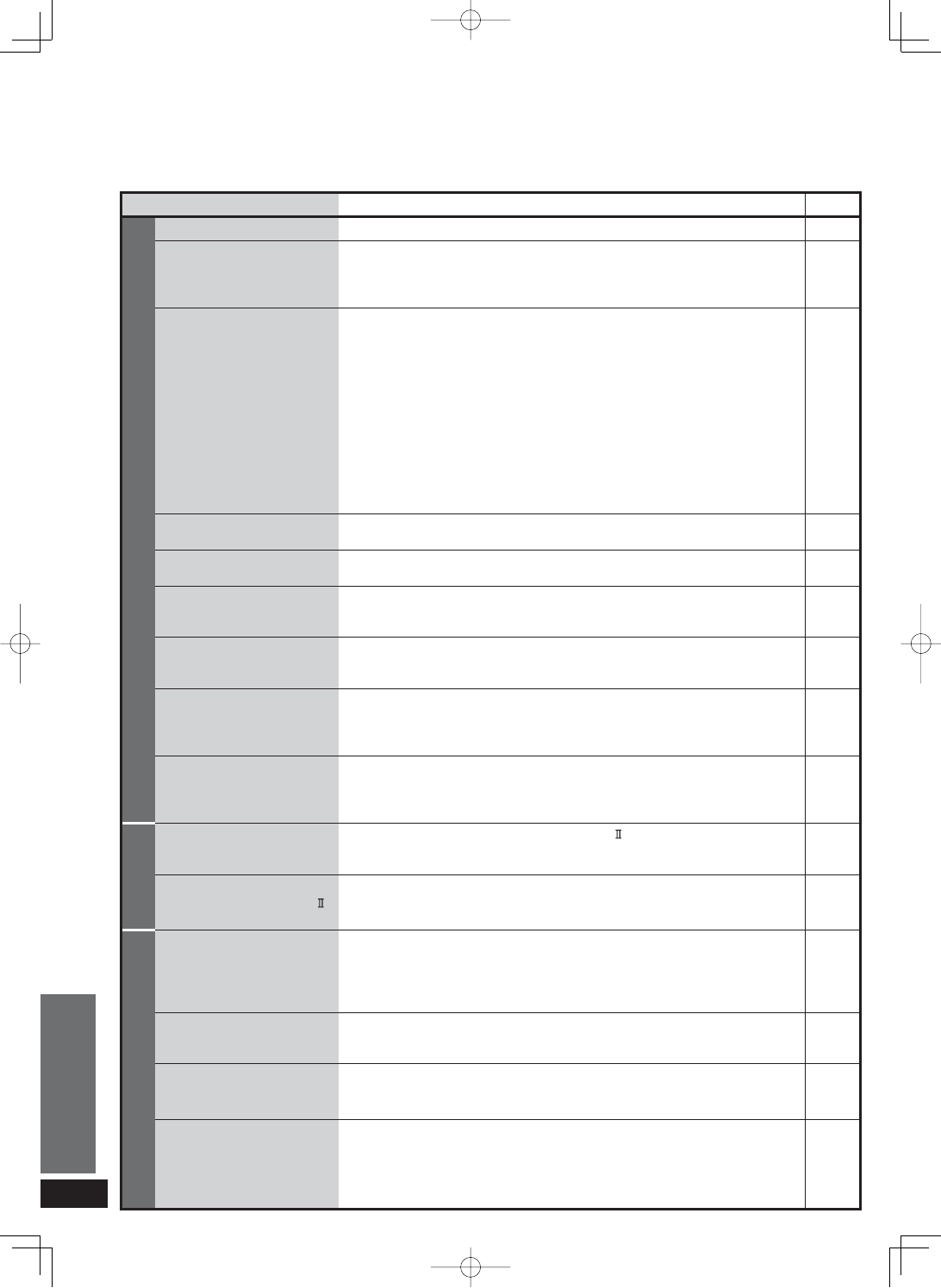
RQT9471
26
Troubleshooting guide
Troubleshooting and
other information
Before requesting service, make the following checks.
If you are in doubt about some of the check points, or if the remedies indicated in the chart do not solve the problem, refer to “Customer Services Directory
(United States and Puerto Rico)” on page 30 if you reside in the U.S.A. or Puerto Rico, or refer to “Product information” on page 29 if you reside in Canada.
Troubleshooting guide
Problem Possible solution Pages
Common problems
No power. • Ensure the AC power supply cord is connected. 12
“2CH SEARCH ” or “4CH
SEARCH ” does not go off
on the display while setting
the speakers.
• Make sure that the speakers are on.
DIf the display does not go off even when the speakers are on, consult your
dealer.
13,15
No sound or image after
playback starts.
• Select the correct source.
• Turn the muting off.
• Check that the digital signals can be decoded by this system.
With the optical fiber connection, cannot playback PCM signal with sampling
frequency of over 96 kHz.
• Check connections to other equipment.
• Set “AUTO ” in “Switching the input signal detection setting”.
• Turn this system off then on again.
• Make sure that the speakers are on.
• Make sure that the speakers have been properly set.
• Adjust the speakers.
• If the connections are normal, this may be a cable-related problem. Use other
cables and make connections again.
16
20
27
9 to 12
24
—
13,15
14
20,21
—
The remote control does
not work.
• Replace the batteries if they are worn.
• Make sure the remote control code has been properly set.
7
24
No sound from microphone
connected to DVD player (karaoke)
.
•
No sound is output from microphone if this system is digitally connected with DVD
player. Change to analog connection and input. Make analog connection to AUX3.
11,12
There is no DTS audio output.
There is audio output, but the
DTS decoder indicator is not lit.
• Set the DTS Digital Audio Output setting on the DVD player, Blu-ray Disc
player or DVD recorder to Bitstream.
• Set “DTS ” in “Switching the input signal detection setting”.
—
24
Sound is not heard when
playing DVD audio.
• This may occur due to digital copyright protection of the disc if using optical
digital connection. This system may not be able to play sources with sampling
frequency of over 48 kHz.
—
“F70 ” appears on
the display.
(“DSP ” or “HDMI ” is
displayed in .)
• Turn off the system, unplug the AC power supply cord, and consult your
dealer.
—
“F76 ” appears on the
display.
(After displayed, the system
turns off.)
• Unplug the AC power supply cord, and consult your dealer. —
Sound fi eld
No sound in surround
mode
• Set to Dolby Virtual Speaker, Dolby Pro Logic or SFC.
• (When the audio is not heard from TV) Check if this system is connected to TV
with the optical fiber cable or the stereo connection cable properly.
17
9 to 11
Cannot use Dolby Virtual
Speaker, Dolby Pro Logic
or SFC.
• You cannot use these features with PCM signals with sampling frequency of
over 48 kHz. Make analog connection to AUX3.
• You cannot use for Dolby Digital dual sounds.
11,12
—
HDMI
When using an HDMI
connection, the fi rst few
seconds of sound is cut off.
• This may occur if you start play from a chapter on a DVD. The following will
correct the problem.
Change the audio output setting on the Blu-ray Disc player, DVD recorder or
DVD player from Bitstream to PCM.
Change input signal setting to “PCM ” in “Switching the input signal detection setting”.
—
24
The system does not work
properly.
• The system does not work properly if you have connected the HDMI input and
output terminals incorrectly. Turn the system off, unplug the AC power supply
cord, and make the connection again.
9
Could watch TV (VIERA)
when installed, but now
cannot watch TV.
• When using this system in combination with TV (VIERA) only, check if HDMI
cable is not connected to “BD/DVD IN” of this system. If it is connected to “BD/
DVD IN”, connect to “TV OUT”.
—
The sounds of the fi rst
few seconds are cut
off when playing back
7.1-channel LPCM
signals.
• This may occur when playing back 7.1-channel LPCM signals of a Blu-ray
disc. Press [u SKIP] on the remote control of recorder or player to play back
again from the beginning.
—
5%<622436;'PKPFF
5%<622436;'PKPFF
ඦ೨
ඦ೨
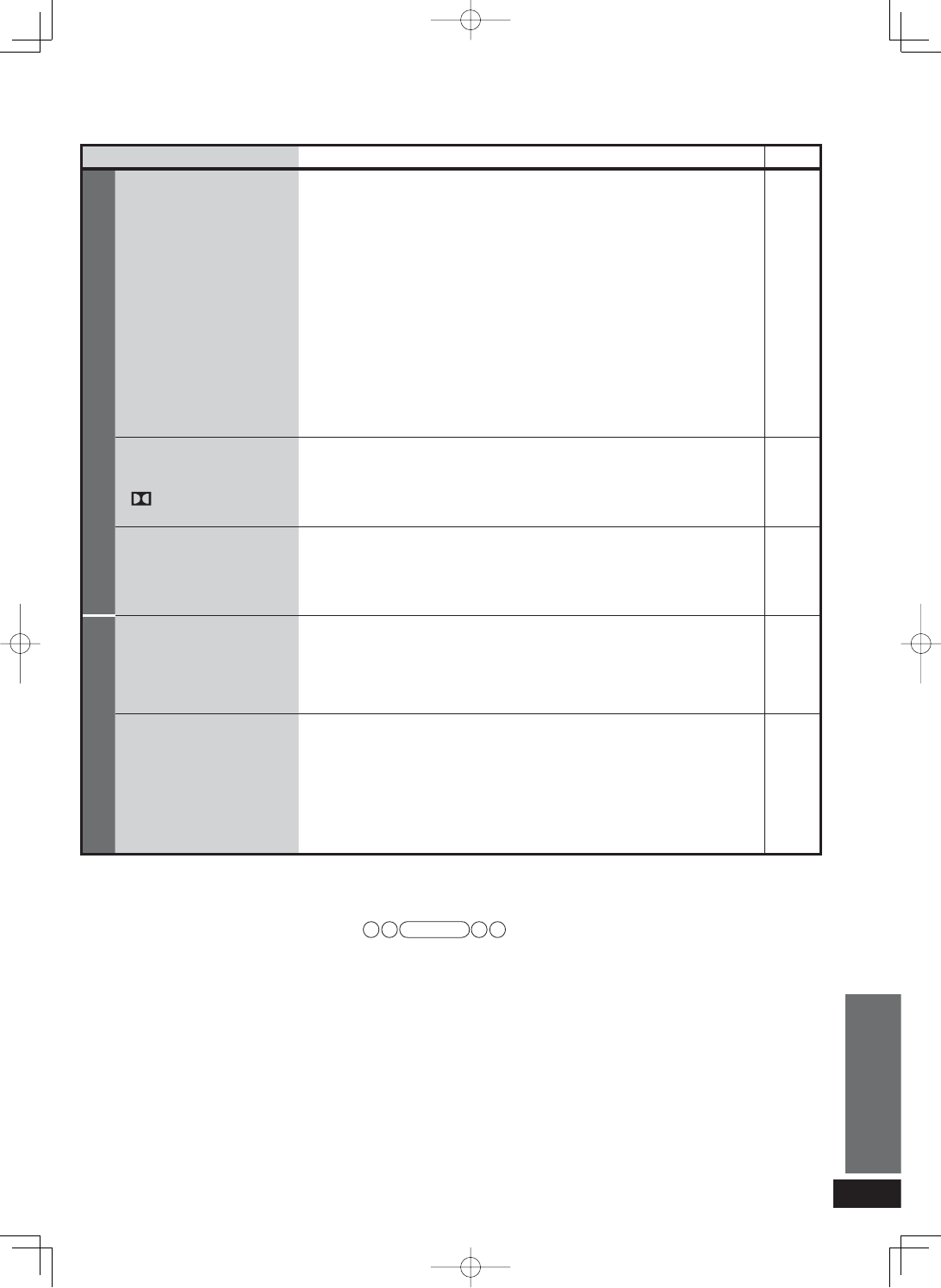
RQT9471
27
Maintenance
Unplug the AC power supply cord from the household AC outlet and wipe the system using a soft and dry cloth.
• When the system is very dirty, wring the cloth soaked in water thoroughly, wipe the dirt and wipe moisture off with a dry cloth.
• Do not use solvents such as benzine, thinner, alcohol, etc. because they may cause casing to deform and coating to come off.
• Before using chemically treated cloth, read the instructions that come with the cloth carefully.
Digital signals that can be played on this system
Note
• With HDMI connection, this system can play back multi-channel LPCM signals
with sampling frequencies of over 48 kHz and PCM signals of over 96 kHz in
addition to multi-channel LPCM of up to 48 kHz and PCM of up to 96 kHz. (If
frequency exceeds these figures, playback equipment performs down-sampling
and plays back as 48 kHz signals. However, playback may be impossible
depending on the discs. See operating instructions of playback equipment for
more information.)
•
With the optical fiber connection, this system can play multi-channel LPCM signals
with sampling frequencies of up to 48 kHz and PCM signals of up to 96 kHz.
• See “Glossary” (➜ page 28) for more detailed information on each signal.
Dolby Digital
Blu-ray disc, DVD etc.
DTS
Blu-ray disc, DVD etc.
PCM (2-channel)
CD, DVD audio etc.
Multi-channel LPCM (Linear PCM)
Blu-ray disc, DVD audio etc.
Troubleshooting and
other information Troubleshooting guide/Digital signals that can be played on this system/Maintenance
Problem Possible solution Pages
HDMI
VIERA Link
“HDAVI Control” does
not function properly.
• Confirm “VIERA Link “HDAVI Control” setting” is set to “ON ” (when the
operation is linked).
When it is “OFF ”, change to “ON ”.
•
VIERA Link “HDAVI Control” does not function in standby condition (HDMI off mode)
when this system is turned off. See “Reducing standby power consumption (In standby
condition (HDMI off mode))” and set to “ON ” (normal power consumption).
• Check VIERA Link “HDAVI Control” settings of the connected equipment.
• VIERA Link “HDAVI Control” may not function when you change the
connections for HDMI equipment, insert and remove the outlet, or during
blackout. Do the following operations in this case.
– Turn on the TV (VIERA) again while all the equipment connected with HDMI
cables is on.
–
Set “VIERA Link “HDAVI Control” (HDMI equipment control)” of TV (VIERA) to “OFF” and
then set to “ON” again. (For details, refer to the operating instructions for TV (VIERA).)
– Connect this system to TV (VIERA) using the HDMI cable, switch the TV
(VIERA) on, unplug this system’s AC power supply cord, and insert it into a
household AC outlet again.
23
22
—
—
Even if multi-channel audio
sources, such as DVD, Blu-ray
disc, are played back,
“ DIGITAL” or “DTS” is not
displayed.
• When using VIERA Link “HDAVI Control” and the speaker is set to “TV”, press
VIERA Link button on the remote control of TV (VIERA) and set the speaker to
“Home Cinema”.
18
This system’s input automatically
switches to “AUX2 / STB ”, but
sound is not heard.
Or unexpected sound from other
equipment is heard.
• After “Setting for automatically switching the input source to STB”, the
connection might have been changed. Select OFF once and SET again.
10
Speakers
[WIRELESS LINK]
indicator on the speakers
does not light green.
Sounds are interrupted.
• When [WIRELESS LINK] indicator is off, check the connection of AC power
supply cord of speaker and check the speaker is “ON”.
•
If [WIRELESS LINK] indicator does not change from red to green, the main unit and speaker are
not linked. Make sure that the main unit is “ON”. Or make the speaker setting again.
•
You may be using wireless headphones or the wireless LAN may be operating near this
system. These symptoms may be remedied by slightly moving this system’s position.
12,13,15
13,15
—
Sound stops.
(The indicator blinks red
and green alternately.)
The protection circuit
is activated when some
abnormality is detected,
and turns off the system
automatically.
• Amplifier output is abnormal.
• Straining of the speakers through excessive volume or power.
• This may occur if you use the system in an extremely hot environment.
DDetermine and correct the cause, then turn the system on.
(The protection circuit is reset.)
(Consult your dealer if the problem persists.)
—
—
—
5%<622436;'PKPFF
5%<622436;'PKPFF
ඦ೨
ඦ೨

RQT9471
28
Glossary
Optical
Using optical fi ber cable for digital signal input/output from DVD,
CD, etc., provides better sound quality for playback or recording
compared to analog. Only possible with equipment that has an
optical terminal.
PCM (Pulse Code Modulation)
This is one of the methods that enable analog sounds to be
converted to digital sounds without compression.
This method is used for music CD, etc.
Sampling frequency
Sampling is the process of converting the heights of sound wave
(analog signal) samples taken at set periods into digits (digital
encoding). Sampling frequency is the number of samples taken
per second, so larger numbers mean faithful reproduction of the
original sound.
Standby through function
When this system and TV and Blu-ray Disc player/DVD recorder
etc. are connected with HDMI cables, image/audio from Blu-
ray Disc player/DVD recorder etc. can still be transmitted to TV
through this system even though the system is turned off.
This is useful when you want to enjoy late night viewing only
with the television’s speakers.
Images recorded with x.v.Color or Deep Color are also
supported.
Surround signal
Audio signal made up with front speakers, center speaker and
surround speakers. When the front speakers are only used for
this system, surround signals are automatically played by Dolby
Virtual Speaker.
WHISPER-MODE SURROUND
Even when the sound volume level is low, you can enjoy
dynamic surround playback similarly as during normal playback.
This is convenient when listening at night.
x.v.Color
This is a name of products compliant with ISO Standard for
wider color space: “xvYCC”. This system supports x.v.Color.
1080p
This is one of the digital hi-vision images.
1080 is the number of effective scanning lines that constitute
the actual screen. This enables every detail to be beautifully
expressed. Images are less fl ickered with progressive method
that scans in order from the top. This system supports 1080p.
5.1-channel surround
Monaural and stereo use one channel and two channels
respectively to reproduce sound, but 5.1-channel surround
uses 5 speakers and 1 subwoofer. The 5 channels are: 1 center
speaker, 2 front speakers, and 2 surround speakers at the
side of or to the rear of the sitting position. Sound output of the
subwoofer is much narrower than the other speakers, and so
is considered as 0.1. This is called 5.1-channel surround when
played through all 5.1 channels, when the front speakers are
only used for this system, you can enjoy the sound fi eld effect
with Dolby Virtual Speaker as if you are listening to 5.1-channel
sources.
7.1-channel virtual surround
When playing back 7.1-channel LPCM signals with this function,
you can enjoy wider sound fi eld effects as if another speaker is
added.
Analog
Audio signals produced from L/R audio output terminals of
general equipment is called analog audio.
CPPM (Content Protection for Prerecorded Media)
This is the copyright protection technology which prevents fi le
copy of DVD audio.
Decoder, Decode
Decoder is the device to enable us to hear audio data that is
encoded on DVD, etc., as a normal audio signal. This process is
called Decode.
Deep Color
This system can reproduce greater color gradation (4096 steps)
when connected to compatible TV and recorder, etc.
You can enjoy exceptionally rich, natural-looking colors, with
smooth, detailed gradation and minimal color banding.
Digital
Blu-ray Disc players, DVD recorders, DVD players, and CD
players are usually equipped with digital output terminals.
Connect through the digital terminal to enjoy digital surround
sounds such as Dolby Digital and DTS.
Dolby Digital
Digital sound compression technology developed by Dolby
Laboratories.
Compatible with surround sound as well as 2-channel stereo
sound. With this technology, you can keep massive amount of
audio data in a disc effi ciently.
Dolby Pro Logic
This system can process not only Dolby Surround, but also
other 2-channel sources to produce a 5.1-channel sound for
a more realistic sound fi eld. It is also possible to enhance old
movies recorded in stereo with this dynamic 5.1-channel sound.
This system uses Dolby Pro Logic to add surround effects to
stereo sources such as video cassettes and CDs.
Dolby Virtual Speaker
This system allows you to enjoy a surround effect with two
front speakers. This is not merely a “virtual surround” effect, but
rather uses the optimal speaker arrangements and listening
positions for 5.1-channel sound.
Down-sampling
This is the process of resampling by reducing the sampling rate
of a signal that was sampled at a certain rate.
DTS (Digital Theater Systems)
Surround system used in most movie theaters. Separation
works well between channels, resulting in realistic surround
effects.
Dynamic range
Dynamic range is the difference between the lowest level of
sound that can be heard above the noise of the equipment and
the highest level of sound before distortion occurs.
HDMI (High Defi nition Multimedia Interface)
HDMI enables you to transmit digital audio and video signals
using a single cable.
You can also transmit control signals using HDMI connections.
Multi-channel LPCM (Linear PCM)
This is the uncompressed audio signal encoded digitally. Multi-
channel LPCM signals used for Blu-ray Disc, DVD audio, etc.
offer playback with higher-sound quality.
Up to 7.1-channel LPCM signals can be input to this system.
Glossary
Troubleshooting and
other information
5%<622436;'PKPFF
5%<622436;'PKPFF
ඦ೨
ඦ೨
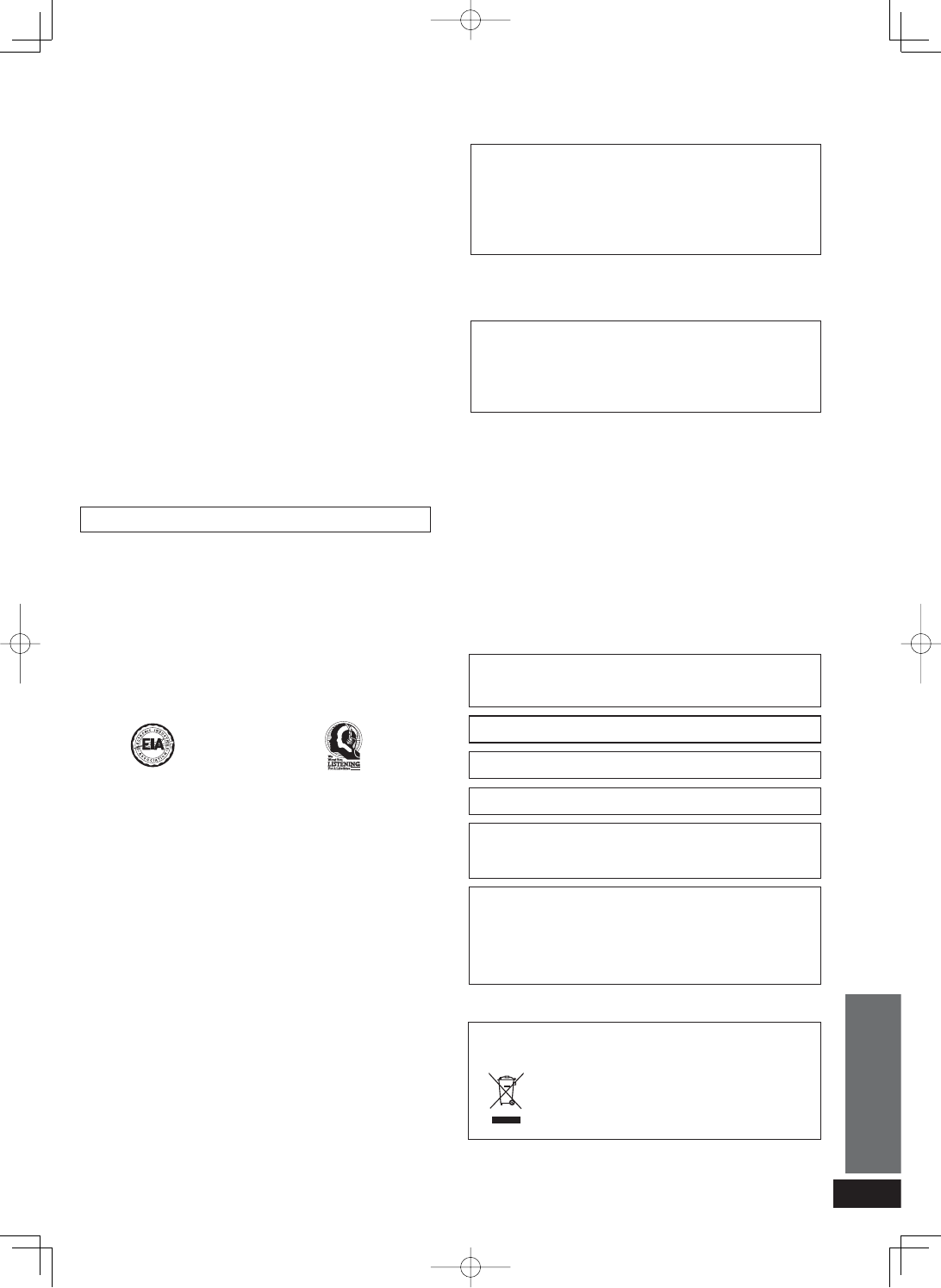
RQT9471
29
-If you see this symbol-
Information on Disposal in other Countries outside the
European Union
This symbol is only valid in the European Union.
If you wish to discard this product, please contact
your local authorities or dealer and ask for the
correct method of disposal.
1. Damage requiring service — The unit should be serviced by
qualifi ed service personnel if:
(a) The AC power supply cord or the plug has been damaged; or
(b) Objects or liquids have gotten into the unit; or
(c) The unit has been exposed to rain; or
(d) The unit does not operate normally or exhibits a marked change
in performance; or
(e) The unit has been dropped or the cabinet damaged.
2. Servicing — Do not attempt to service the unit beyond that
described in these operating instructions. Refer all other servicing to
authorized servicing personnel.
3. Replacement parts — When parts need replacing ensure the
servicer uses parts specifi ed by the manufacturer or parts that
have the same characteristics as the original parts. Unauthorized
substitutes may result in fi re, electric shock, or other hazards.
4. Safety check — After repairs or service, ask the servicer to perform
safety checks to confi rm that the unit is in proper working condition.
The servicer will require all components to service your system.
Therefore, should service ever be necessary, be sure to bring the
entire system.
For product information or assistance with product operation:
In the U.S.A. and Puerto Rico, refer to “Customer Services Directory
(United States and Puerto Rico)” on page 30.
In Canada, contact the Panasonic Canada Inc. Customer Care Centre
at 1-800-561-5505, or visit the website (www.panasonic.ca), or an
authorized Servicentre closest to you.
DATE OF PURCHASE __________________________________
DEALER NAME _______________________________________
DEALER ADDRESS ____________________________________
_____________________________________________________
TELEPHONE NUMBER _________________________________
User memo:
Product information
The model number and serial number of this product can be found
on either the back or the bottom of the unit.
Please note them in the space provided below and keep for future
reference.
MODEL NUMBER _______________________________________
SERIAL NUMBER _______________________________________
SC-ZT1
Troubleshooting and
other information Product Service/Listening caution
Selecting fi ne audio equipment such as the unit you’ve just purchased
is only the start of your musical enjoyment. Now it’s time to consider
how you can maximize the fun and excitement your equipment offers.
This manufacturer and the Electronic Industries Association’s
Consumer Electronics Group want you to get the most out of your
equipment by playing it at a safe level. One that lets the sound come
through loud and clear without annoying blaring or distortion-and, most
importantly, without affecting your sensitive hearing.
We recommend that you avoid prolonged exposure to excessive noise.
Sound can be deceiving. Over time your hearing “comfort level” adapts
to higher volumes of sound. So what sounds “normal” can actually be
loud and harmful to your hearing.
Guard against this by setting your equipment at a safe level BEFORE
your hearing adapts.
To establish a safe level:
Start your volume control at a low setting.
Slowly increase the sound until you can hear it comfortably and
clearly, and without distortion.
Once you have established a comfortable sound level:
Set the dial and leave it there.
Taking a minute to do this now will help to prevent hearing damage or
loss in the future. After all, we want you listening for a lifetime.
•
•
•
EST. 1924
Manufactured under license from Dolby Laboratories.
Dolby, Pro Logic, and the double-D symbol are trademarks of
Dolby Laboratories.
HDMI, the HDMI logo and High-Defi nition Multimedia
Interface are trademarks or registered trademarks of HDMI
Licensing LLC.
HDAVI Control™ is a trademark of Panasonic Corporation.
Manufactured under license under U.S. Patent #’s: 5,451,942;
5,956,674; 5,974,380; 5,978,762; 6,487,535 & other U.S. and
worldwide patents issued & pending. DTS and DTS Digital
Surround are registered trademarks and the DTS logos and
Symbol are trademarks of DTS, Inc. © 1996-2008 DTS, Inc.
All Rights Reserved.
EZ Sync™ is a trademark of Panasonic Corporation.
VIERA Link™ is a trademark of Panasonic Corporation.
Product Service
Listening caution
5%<622436;'PKPFF
5%<622436;'PKPFF
ඦ೨
ඦ೨

RQT9471
30
Limited Warranty (ONLY FOR U.S.A. AND PUERTO RICO)
Panasonic Consumer Electronics Company,
Division of Panasonic Corporation of North America
One Panasonic Way, Secaucus, New Jersey 07094
Panasonic Audio Products
Limited Warranty
Limited Warranty Coverage (For USA and Puerto Rico Only)
If your product does not work properly because of a defect in materials or workmanship,
Panasonic Consumer Electronics Company (referred to as
“t
he warrantor”) will, for the
length of the period indicated on the chart below, which starts with the date of original
purchase (“warranty period”), at its option either (a) repair your product with new or
refurbished parts, or (b) replace it with a new or a refurbished product. The decision to
repair or replace will be made by the warrantor.
During the “Labor” warranty period there will be no charge for labor. During the “Parts”
warranty period, there will be no charge for parts. You must carry-in or mail-in your
product during the warranty period. If non-rechargeable batteries are included, they are
not warranted. This warranty only applies to products purchased and serviced in the
United States or Puerto Rico. This warranty is extended only to the original purchaser of
a new product which was not sold “as is”. A purchase receipt or other proof of the original
purchase date is required for warranty service.
Carry-In or Mail-In Service
For Carry-In or Mail-In Service in the United States and Puerto Rico call
1-800-211-PANA (7262) or visit Panasonic Web Site: http://www.panasonic.com
Limited Warranty Limits And Exclusions
This warranty ONLY COVERS failures due to defects in materials or workmanship, and
DOES NOT COVER normal wear and tear or cosmetic damage. The warranty ALSO
DOES NOT COVER damages which occurred in shipment, or failures which are caused
by products not supplied by the warrantor, or failures which result from accidents,
misuse, abuse, neglect, mishandling, misapplication, alteration, faulty installation, set-up
adjustments, misadjustment of consumer controls, improper maintenance, power line
surge, lightning damage, modification, or commercial use (such as in a hotel, office,
restaurant, or other business), rental use of the product, service by anyone other than a
Factory Service Center or other Authorized Servicer, or damage that is attributable to acts
of God.
THERE ARE NO EXPRESS WARRANTIES EXCEPT AS LISTED UNDER
“
LIMITED
WARRANTY COVERAGE”. THE WARRANTOR IS NOT LIABLE FOR INCIDENTAL OR
CONSEQUENTIAL DAMAGES RESULTING FROM THE USE OF THIS PRODUCT, OR
ARISING OUT OF ANY BREACH OF THIS WARRANTY. (As examples, this ex cludes
damages for lost time, travel to and from the servicer, loss of media or images, data or
other memory content. The items listed are not exclusive, but are for illustration only.)
ALL EXPRESS AND IMPLIED WARRANTIES, INCLUDING THE WARRANTY OF
MERCHANTABILITY, ARE LIMITED TO THE PERIOD OF THE LIMITED WARRANTY.
Some states do not allow the exclusion or limitation of incidental or consequential damages, or
limitations on how long an implied warranty lasts, so the exclusions may not apply to you.
This warranty gives you specific legal rights and you may also have other rights which vary from
state to state. If a problem with this product develops during or after the warranty period, you
may contact your dealer or Service Center. If the problem is not handled to your satisfaction, then
write to the warrantor’s Consumer Affairs Department at the addresses listed for the warrantor.
PARTS AND SERVICE WHICH ARE NOT COVERED BY THIS LIMITED WARRANTY
ARE YOUR RESPONSIBILITY.
Customer Services Directory (United States and Puerto Rico)
Obtain Product Information and Operating Assistance; locate your nearest Dealer or Service Center; purchase Parts
and Accessories; or make Customer Service and Literature requests by visiting our Web Site at:
http://www.panasonic.com/help
or, contact us via the web at:
http://www.panasonic.com/contactinfo
You may also contact us directly at:
1-800-211-PANA (7262),
Monday-Friday 9 am-9 pm; Saturday-Sunday 10 am-7 pm, EST.
For hearing or speech impaired TTY users, TTY: 1-877-833-8855
Accessory Purchases (United States and Puerto Rico)
Purchase Parts, Accessories and Instruction Books online for all Panasonic Products by visiting our Web Site at:
http://www.pstc.panasonic.com
or, send your request by E-mail to:
npcparts@us.panasonic.com
You may also contact us directly at:
1-800-332-5368 (Phone) 1-800-237-9080 (Fax Only) (Monday – Friday 9 am to 9 pm, EST.)
Panasonic Service and Technology Company
20421 84th Avenue South, Kent, WA 98032
(We Accept Visa, MasterCard, Discover Card, American Express, and Personal Checks)
For hearing or speech impaired TTY users, TTY: 1-866-605-1277
USB Reader-Writer, Personal Computer
Card Adapters
(in exchange for defective item)
Accessories: Headphones, Cartridges,
Microphones, Adapters
Rechargeable Batteries, DVD-R/-RAM Discs
(in exchange for defective item)
SD Memory Cards, Rechargeable Battery
Packs (in exchange for defective item)
One (1) year
Ninety (90) days
Ten (10) days
Ninety (90) days
Not Applicable
Ninety (90) days
Not Applicable
Not Applicable
Product or Part Name
Audio Products (except items listed below)
Parts
One (1) year One (1) year
Labor
As of October 2008
Limited Warranty (ONLY FOR U.S.A. AND PUERTO RICO)
Troubleshooting and
other information
5%<622436;'PKPFF
5%<622436;'PKPFF
ඦ೨
ඦ೨

RQT9471
31
Limited Warranty (ONLY FOR CANADA)
Panasonic Canada Inc.
PANASONIC PRODUCT – LIMITED WARRANTY
Panasonic Canada Inc. warrants this product to be free from defects in material and workmanship and agrees to remedy any
such defect for a period as stated below from the date of original purchase.
Technics Audio Product One (1) year, parts and labour
Panasonic Portable / Clock Radio (without Tape, CD, MD) One (1) year, parts and labour
Panasonic Audio / SD Audio Product One (1) year, parts and labour
Panasonic DVD Product One (1) year, parts and labour
Panasonic Combination DVD Player / VCR One (1) year, parts and labour
Panasonic Combination DVD Recorder / VCR One (1) year, parts and labour
Accessories including rechargeable batteries Ninety (90) days
LIMITATIONS AND EXCLUSIONS
This warranty does not apply to products purchased outside Canada or to any product which has been improperly installed,
subjected to usage for which the product was not designed, misused or abused, damaged during shipping, or which has
been altered or repaired in any way that affects the reliability or detracts from the performance, nor does it cover any product
which is used commercially. Dry cell batteries are also excluded from coverage under this warranty.
This warranty is extended to the original end user purchaser only. A purchase receipt or other proof of date of original
purchase is required before warranty service is performed.
THIS EXPRESS, LIMITED WARRANTY IS IN LIEU OF ALL OTHER WARRANTIES, EXPRESS OR IMPLIED,
INCLUDING ANY IMPLIED WARRANTIES OF MERCHANTABILITY AND FITNESS FOR A PARTICULAR PURPOSE.
IN NO EVENT WILL PANASONIC CANADA INC. BE LIABLE FOR ANY SPECIAL, INDIRECT OR CONSEQUENTIAL
DAMAGES.
In certain instances, some jurisdictions do not allow the exclusion or limitation of incidental or consequential damages, or the
exclusion of implied warranties, so the above limitations and exclusions may not be applicable.
WARRANTY SERVICE
FOR PRODUCT OPERATION ASSISTANCE, please contact:
Our Customer Care Centre: Telephone #: (905) 624-5505
1-800 #: 1-800-561-5505
Fax #: (905) 238-2360
Email link: “Customer support” on www.panasonic.ca
FOR PRODUCT REPAIRS, please locate your nearest Authorized Servicentre at www.panasonic.ca :
Link : “ServicentresTM locator” under “Customer support”
IF YOU SHIP THE PRODUCT TO A SERVICENTRE
Carefully pack and send prepaid, adequately insured and preferably in the original carton.
Include details of the defect claimed, and proof of date of original purchase.
Troubleshooting and
other information Limited Warranty (ONLY FOR CANADA)
5%<622436;'PKPFF
5%<622436;'PKPFF
ඦ೨
ඦ೨

RQT9471
32
This device complies with RSS-210 of the IC Rules.
Operation is subject to the following two conditions:
(1) This device may not cause harmful interference,
(2) This device must accept any interference received,
including interference that may cause undesired operation of the device.
This equipment complies with IC radiation exposure limits set forth for uncontrolled equipment and meets RSS-102 of the
IC radio frequency (RF) Exposure rules. This equipment has very low levels of RF energy that it deemed to comply without
maximum permissive exposure evaluation (MPE). But it is desirable that it should be installed and operated with at least 20 cm
and more between the radiator and person’s body (excluding extremities: hands,wrists,feet and ankles).
THE FOLLOWING APPLIES ONLY IN CANADA.
Safety precautions
• Do not use this device in hospitals and other places where electric medical devices are installed.
• Do not use this device near automatic doors, fire alarms and other automatically controlled apparatuses.
• Do not hold the speaker with one hand.
•
Before attaching the leg cushion on the base parts to prevent tilt or rattle on the floor, make sure there are no people in the surrounding area.
• Do not insert your hand or foot into the opening of side surface of base part.
• Do not turn on the speakers with foot or vacuum cleaner carelessly.
• Do not use this device as a plaything.
This Class B digital apparatus complies with Canadian ICES-003.
THE FOLLOWING APPLIES ONLY IN CANADA.
Panasonic Consumer Electronics
Company, Division of Panasonic
Corporation of North America
One Panasonic Way, Secaucus,
New Jersey 07094
http://www.panasonic.com
© Panasonic Corporation 2009
Printed in Malaysia
Panasonic Canada Inc.
5770 Ambler Drive
Mississauga, Ontario
L4W 2T3
www.panasonic.ca
FCC Note:
This equipment has been tested and found to comply with the limits for a Class B digital device, pursuant to Part 15 of the FCC Rules.
These limits are designed to provide reasonable protection against harmful interference in a residential installation. This equipment
generates, uses and can radiate radio frequency energy and, if not installed and used in accordance with the instructions, may
cause harmful interference to radio communications.
However, there is no guarantee that interference will not occur in a particular installation. If this equipment does cause harmful
interference to radio or television reception, which can be determined by turning the equipment off and on, the user is encouraged
to try to correct the interference by one or more of the following measures:
* Reorient or relocate the receiving antenna.
* Increase the separation between the equipment and receiver.
* Connect the equipment into an outlet on a circuit different from that to which the receiver is connected.
* Consult the dealer or an experienced radio/TV technician for help.
FCC caution: To maintain compliance with FCC regulations, shielded interface cables must be used with this equipment.
Operation with non-approved equipment or unshielded cables may result in interference to radio and TV reception. Any changes
or modifi cations not approved by the party responsible for compliance could void the user’s authority to operate this equipment.
This device complies with Part 15 of the FCC Rules.
Operation is subject to the following two conditions:
(1) This device may not cause harmful interference, and
(2) this device must accept any interference received, including interference that may cause undesired operation.
This transmitter must not be co-located or operated in conjunction with any other antenna or transmitter.
This equipment complies with FCC radiation exposure limits set forth for uncontrolled equipment and meets the FCC radio
frequency (RF) Exposure Guidelines in Supplement C to OET65. This equipment has very low levels of RF energy that it deemed
to comply without maximum permissive exposure evaluation (MPE). But it is desirable that it should be installed and operated with
at least 20 cm and more between the radiator and person’s body (excluding extremities: hands,wrists,feet and ankles).
Responsible Party:
Panasonic Corporation of North America
One Panasonic Way
Secaucus, NJ 07094
Support Contact:
Panasonic Consumer Electronics Company
Telephone No.: 1-800-211-PANA (7262)
THE FOLLOWING APPLIES ONLY IN THE U.S.A.
5%<622436;'PKPFF
5%<622436;'PKPFF
ඦ೨
ඦ೨